You'll love these delicious German bread dumplings, with their delicious flavour and distinctive texture, they're perfect to serve with a roast dinner.
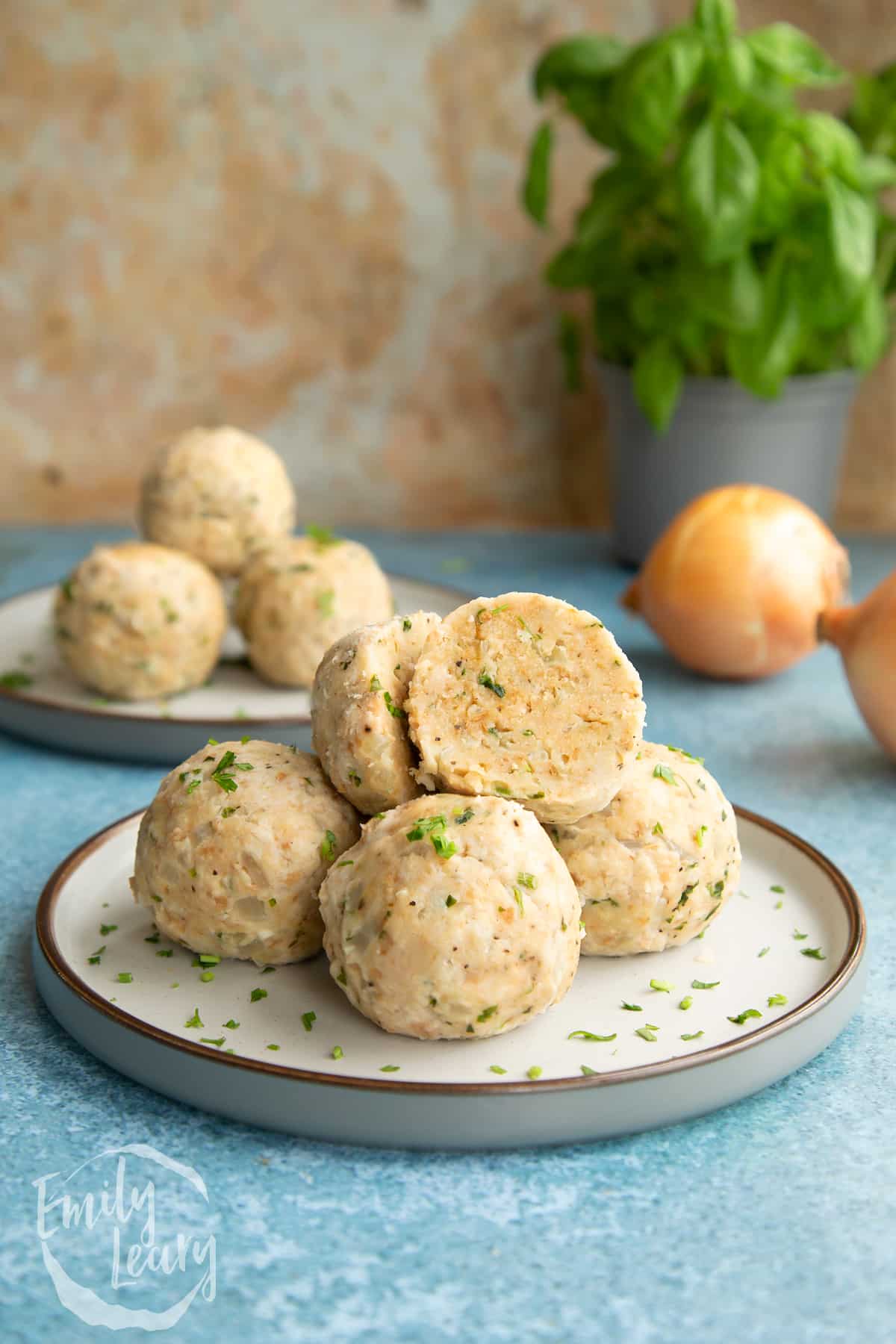
German bread dumplings (also known as Semmelknödel) are a traditional Bavarian dish. They are made from bread, eggs, and milk, and often served with gravy or sauce.
My version of these dumplings are enriched with a little butter and flavoured with onion and parsley, which is pretty traditional, although I also like to include a bit of garlic, which is less so.
If you're curious about the flavour of German bread dumplings, they taste like a cross between stuffing and dumplings and make a great addition to any meal, or even as a meal in themselves.
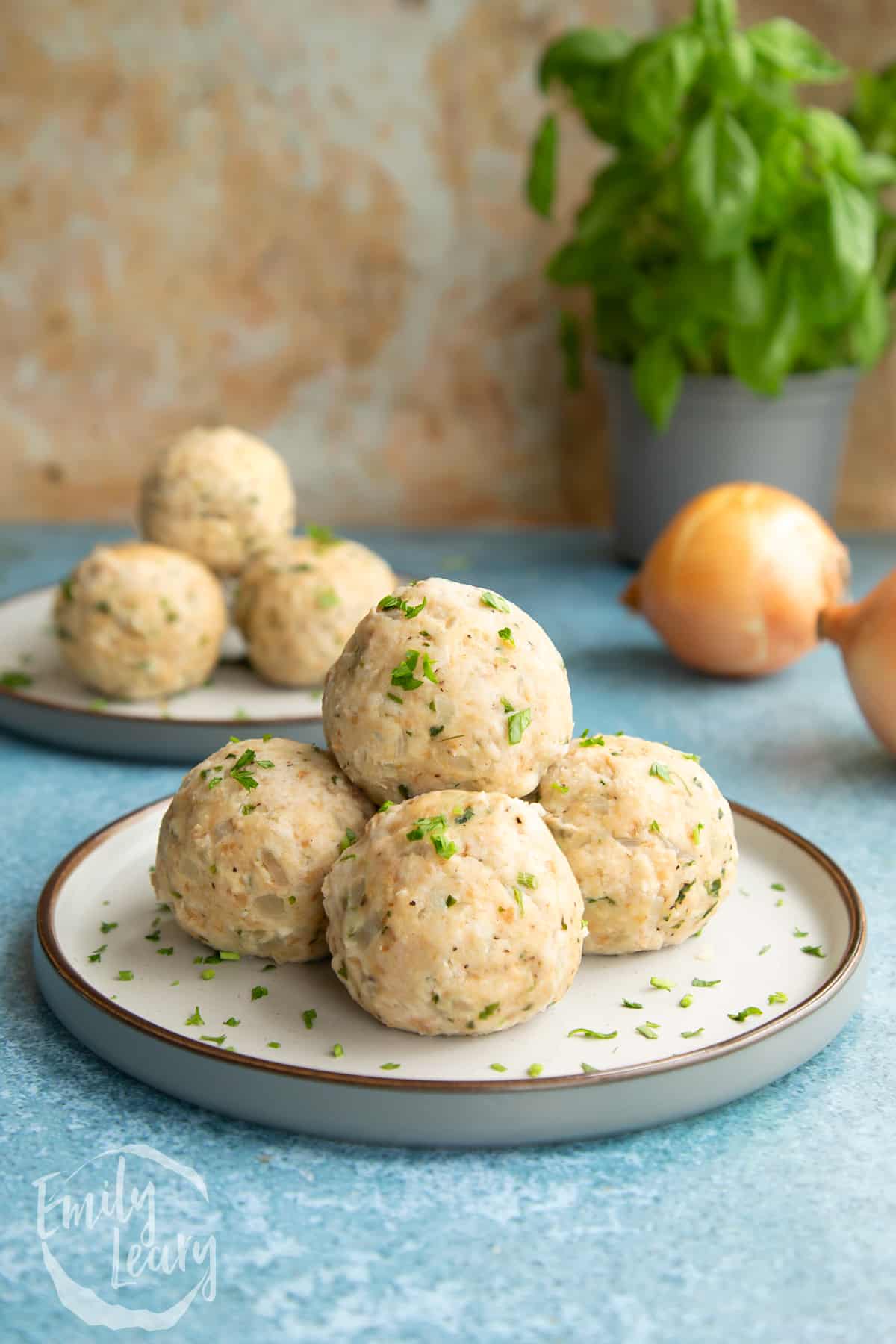
UK readers might find them to have a very similar flavour to bread sauce and many other cultures enjoy bread or toast dipped in milk (hot or cold) so whether you've tried something similar or not, the chances are, you're going to love Semmelknödel!
The main ingredient in this German dumplings is stale white bread, so if you often find that you have the end of a loaf at the back of the bread bin when the weekend swings around, then this is a perfect recipe to make and serve with your Sunday roast.
Traditionally, you would cut the bread into very small cubes.
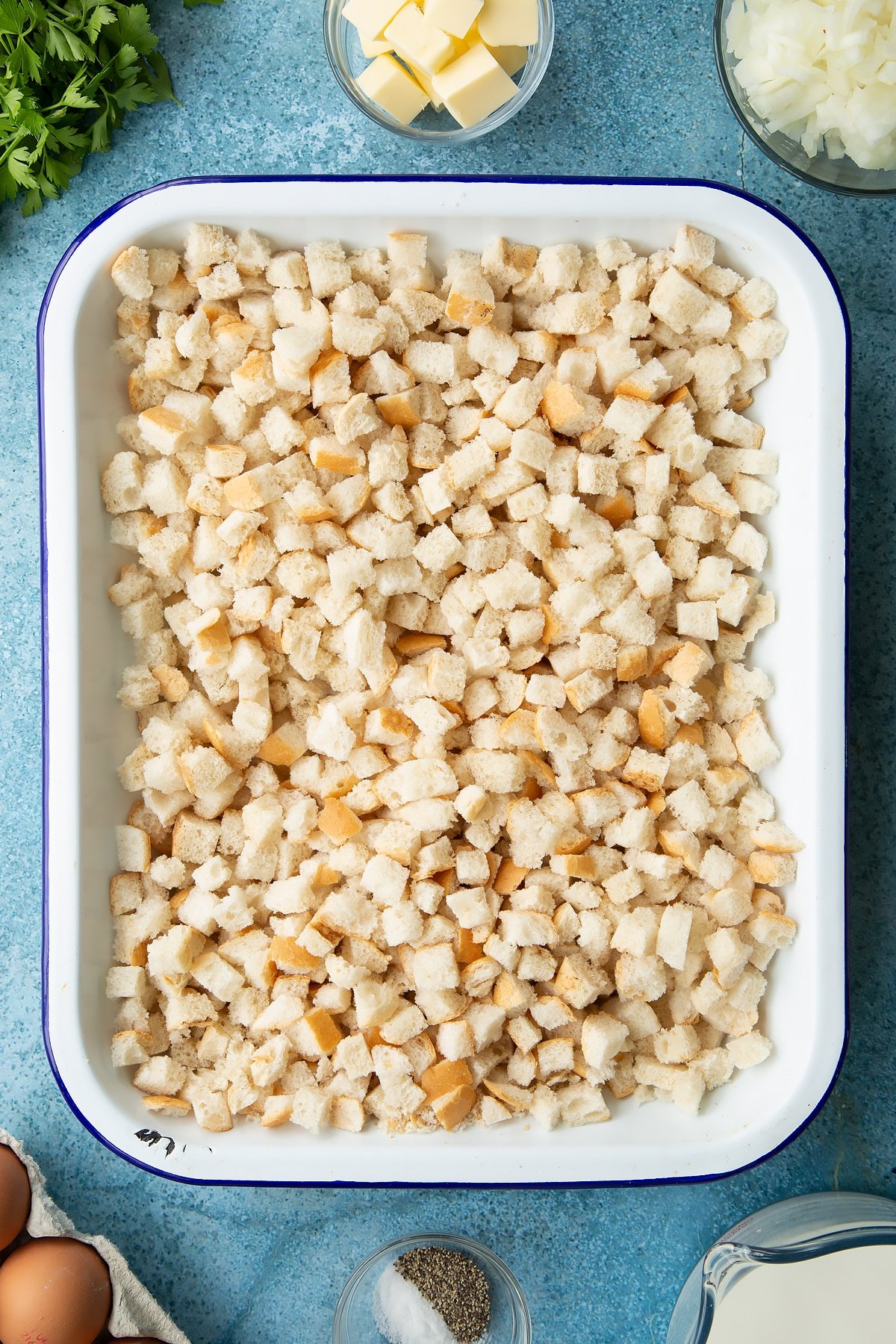
However, I like to blend the bread briefly in a food processor. It means the liquid absorbs straight away and ensures you get an even mix.
Many recipes call for the bread to be broken up once the liquids are added in any case, so the result is much the same, just a little more uniform.
Furthermore, with cubed bread I found that there's always the risk of missing some pieces when breaking the mixture up in the liquid. This can create highly absorbent weak spots in the dumplings, making them more likely to fall apart when cooked.
So that's why I prefer using breadcrumbs, but if you feel confident and prefer a traditional approach with a chunkier texture, go ahead and use cubed bread, just be sure to let it soak in the liquid so that no dry pieces are left when you start shaping.
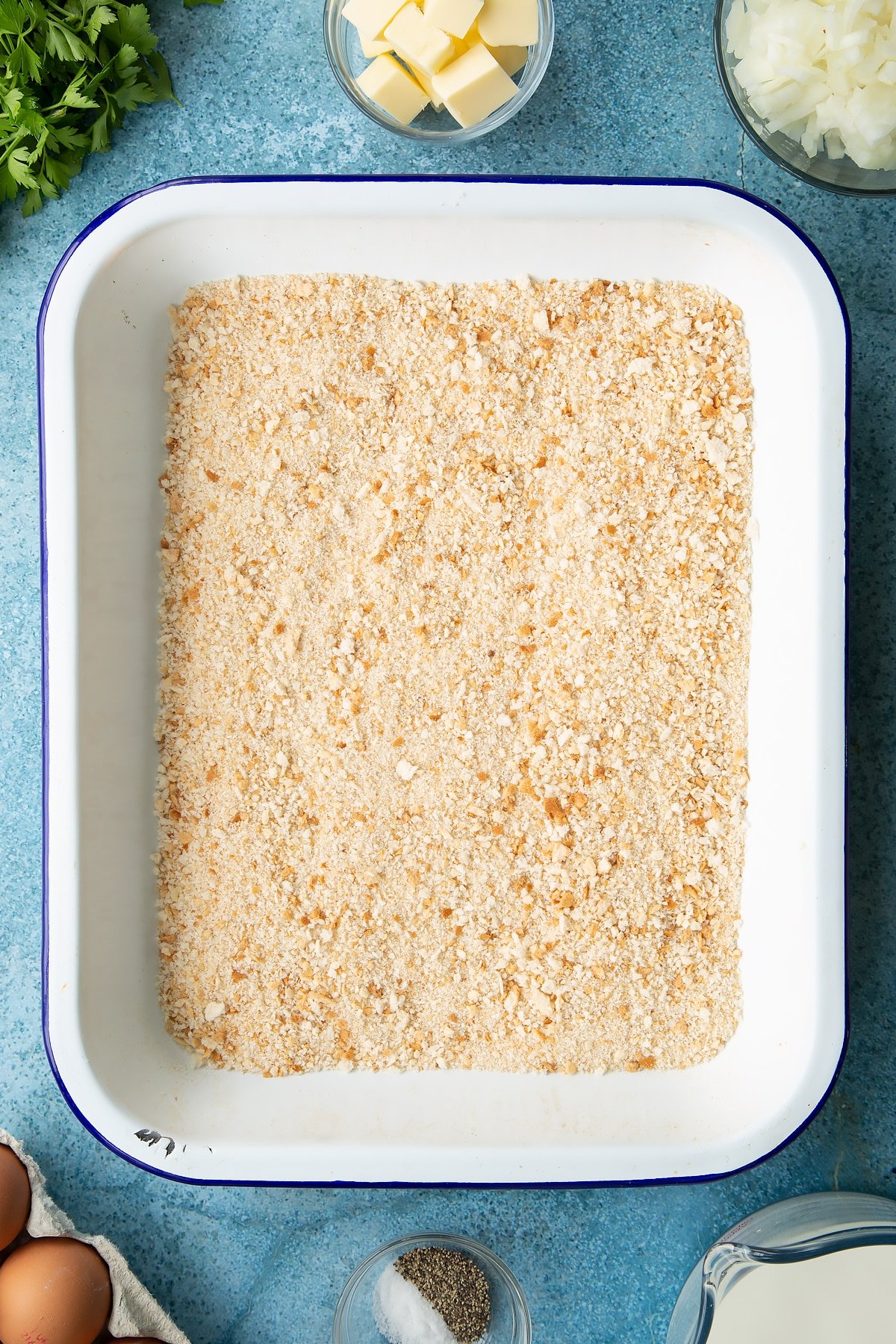
Once the bread is spread in a tray, you'll sweat onions, garlic and fresh parsley in batter and then tip them on top of the bread.
Next comes the other key ingredient in these German bread dumplings: hot milk, enriched with a touch of melted butter. This is followed by beaten eggs, which are vital in binding everything together.
A touch of salt in pepper and your ready to stir your mixture together and form it into large balls.
Your German bread dumplings are then cooked in simmering water for around 20 minutes, until they're set and surprisingly moreish. Some like to use broth or stock to simmer the dumplings in, which can add another lovely level of flavour to the finished dish.

I like to serve my Semmelknödel with a simple gravy made from the juices of whatever meat we're roasting, but they're also great in any stew where you would normally use flour or potato dumplings. German bread dumplings are also wonderful with mushroom dishes or sauerkraut, another German dish of fermented cabbage.
Here's the full recipe for eight large German bread dumplings, complete with photographs to help you at every stage.
Ingredients
- 300 g (10.6 oz) stale white bread crusty rolls are perfect for this
- 4 tbsp salted butter
- 1 medium onion finely diced
- 15 g (0.5 oz) fresh parsley finely chopped
- 2 cloves garlic finely chopped, optional
- 300 ml (10.1 floz) milk
- 3 medium free range eggs lightly beaten
- 1/2 tsp (0.5 tsp) freshly ground black pepper
- 1/2 tsp (0.5 tsp) salt
Equipment
- Large nonstick baking tray
- Large saucepan wide and shallow
Instructions
Break the stale bread into smallish chunks and drop into a food processor to turn into large crumbs. If you don't have a food processor, you can grate the bread or chop it up into small pieces. Spread in a tray and leave to dry out further overnight.
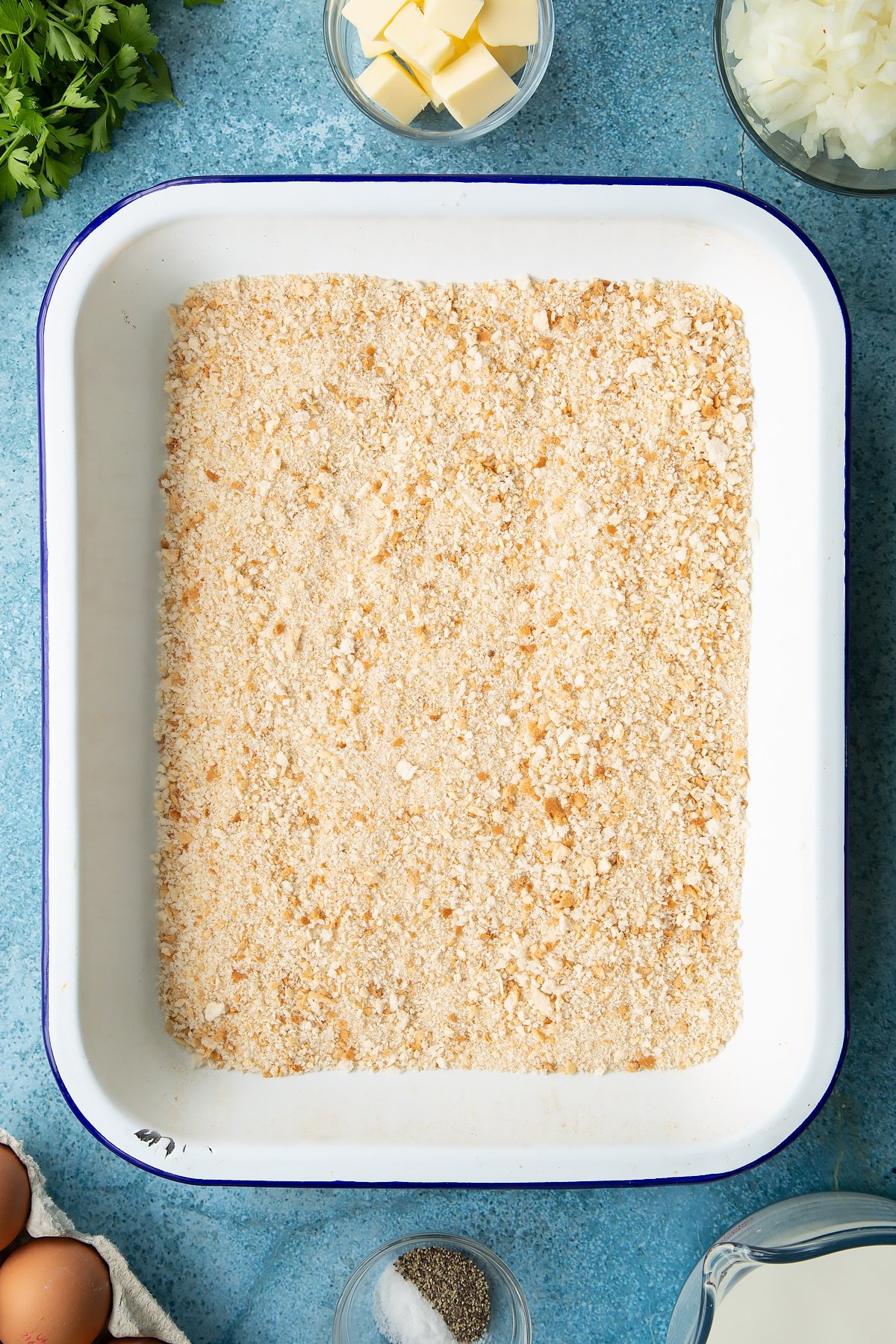
Place half the butter in a frying pan.
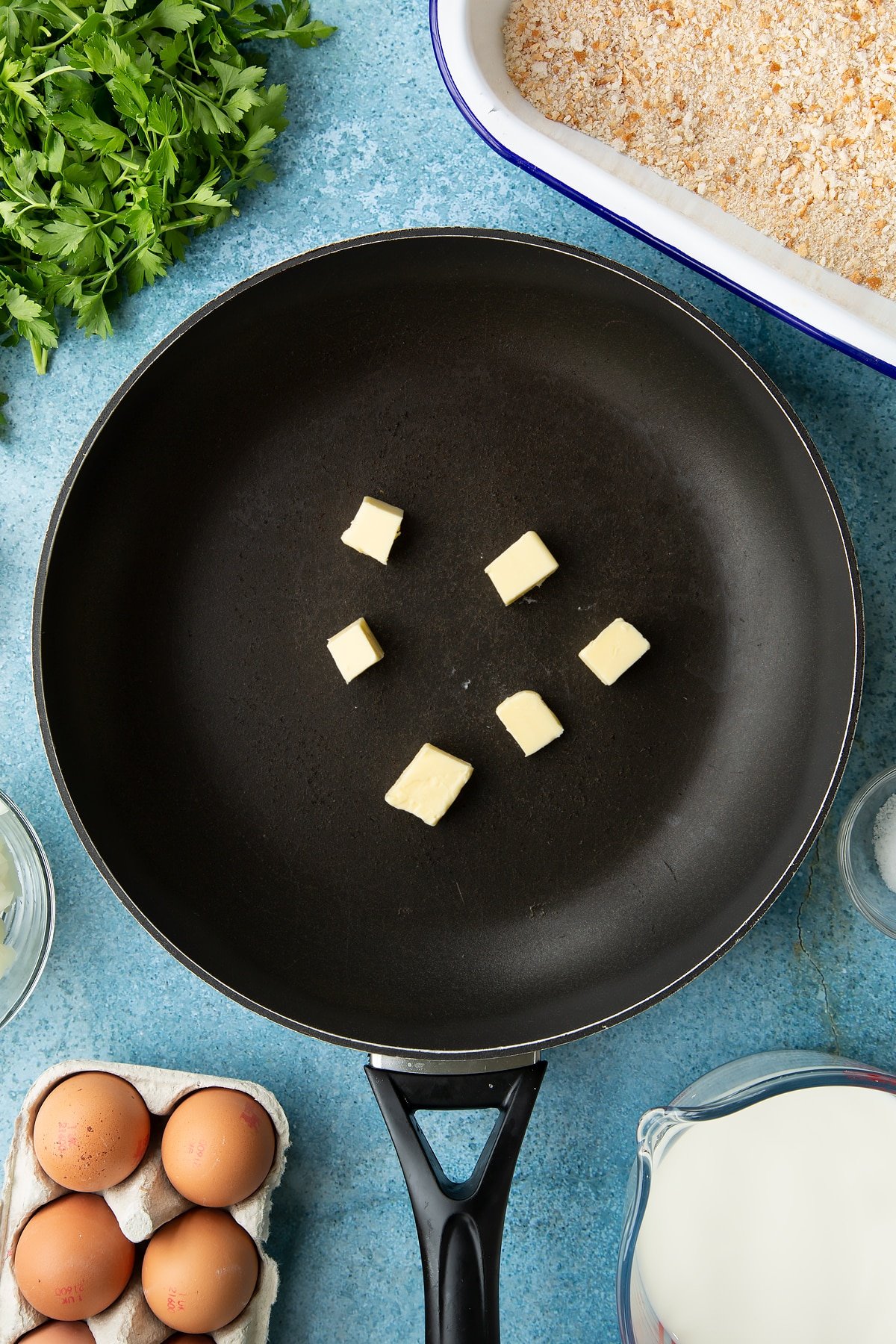
Melt over a medium heat.
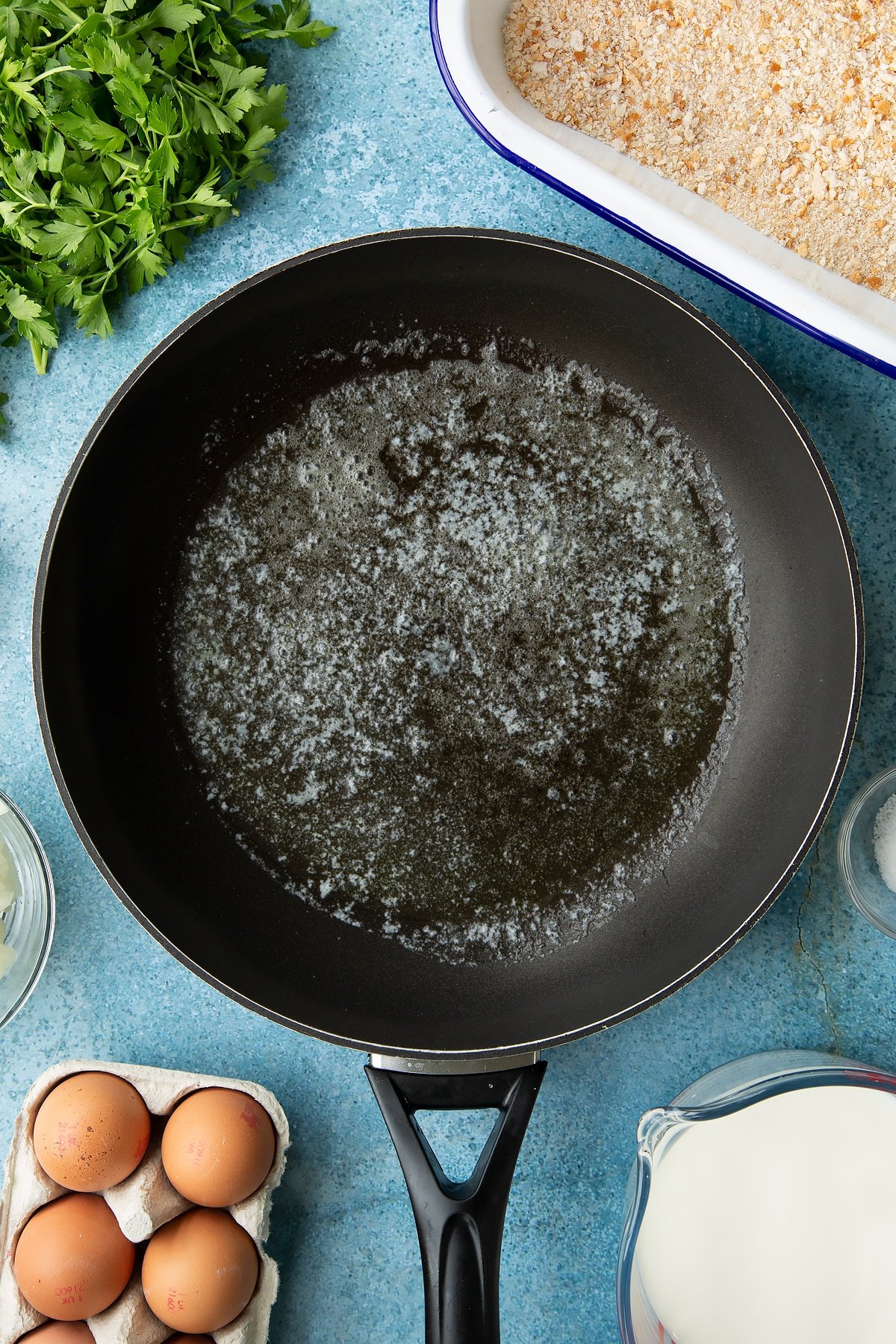
Add the onions.
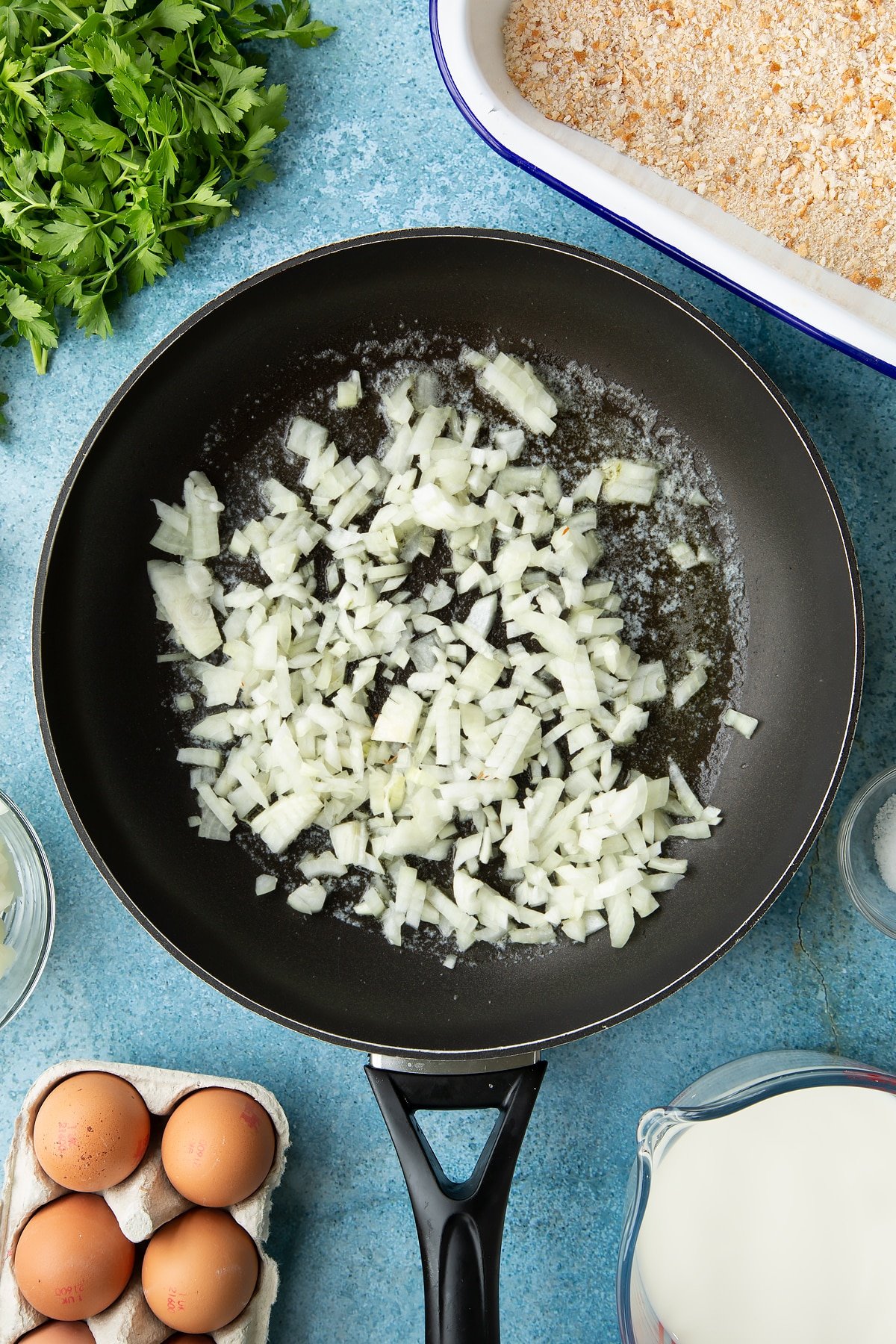
Sweat until they start to become translucent.
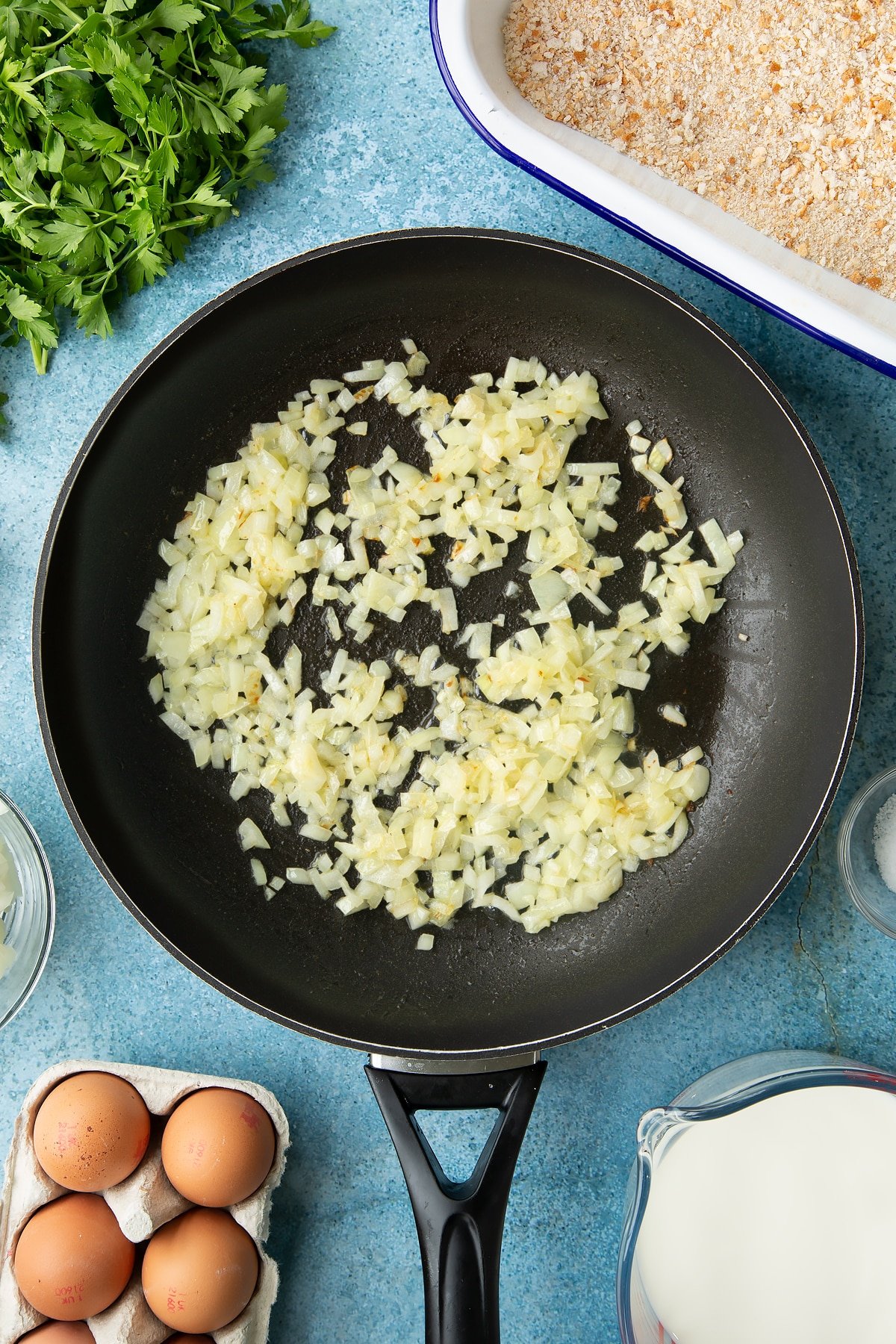
Add the parsley.
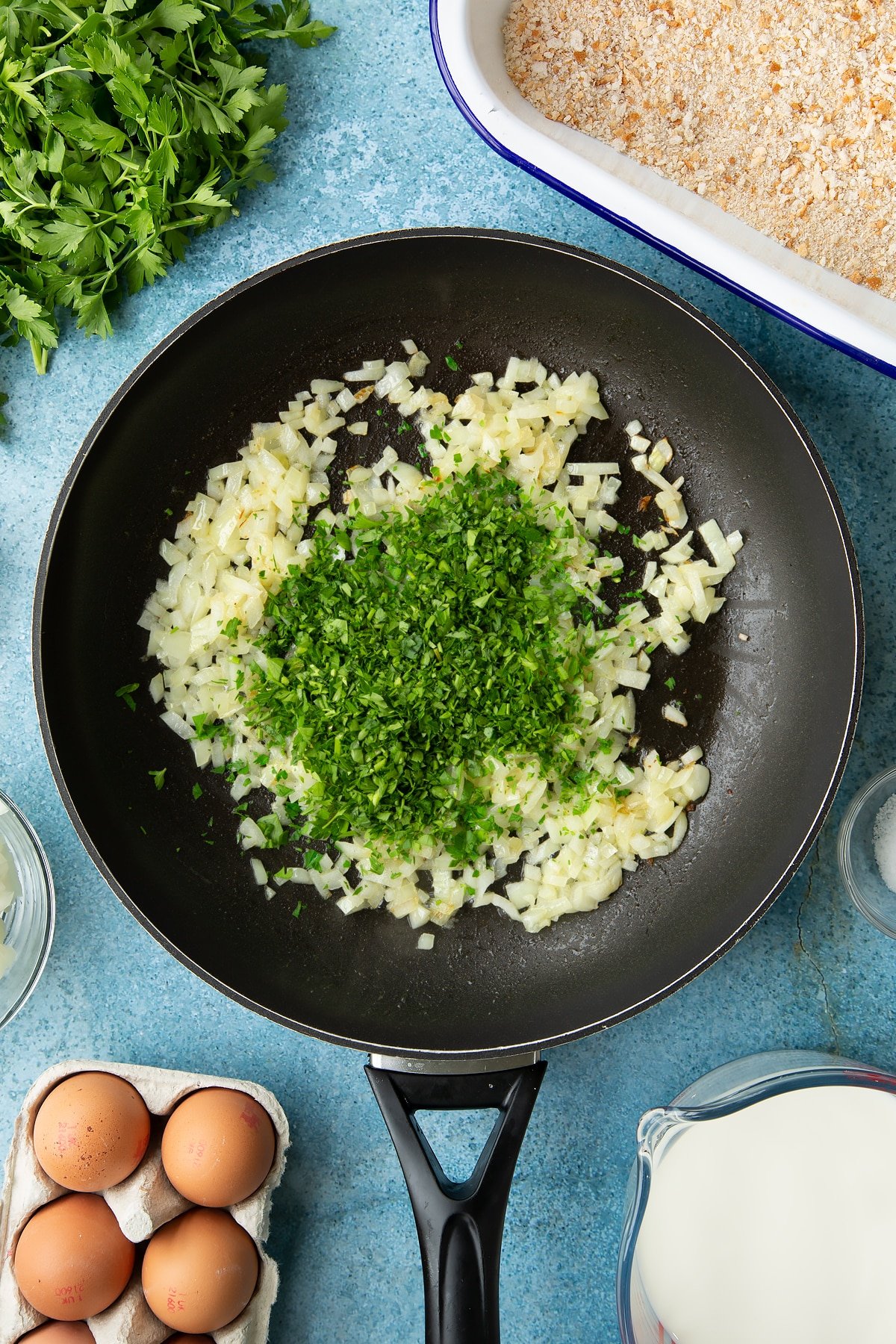
Cook for 10 minutes on low.
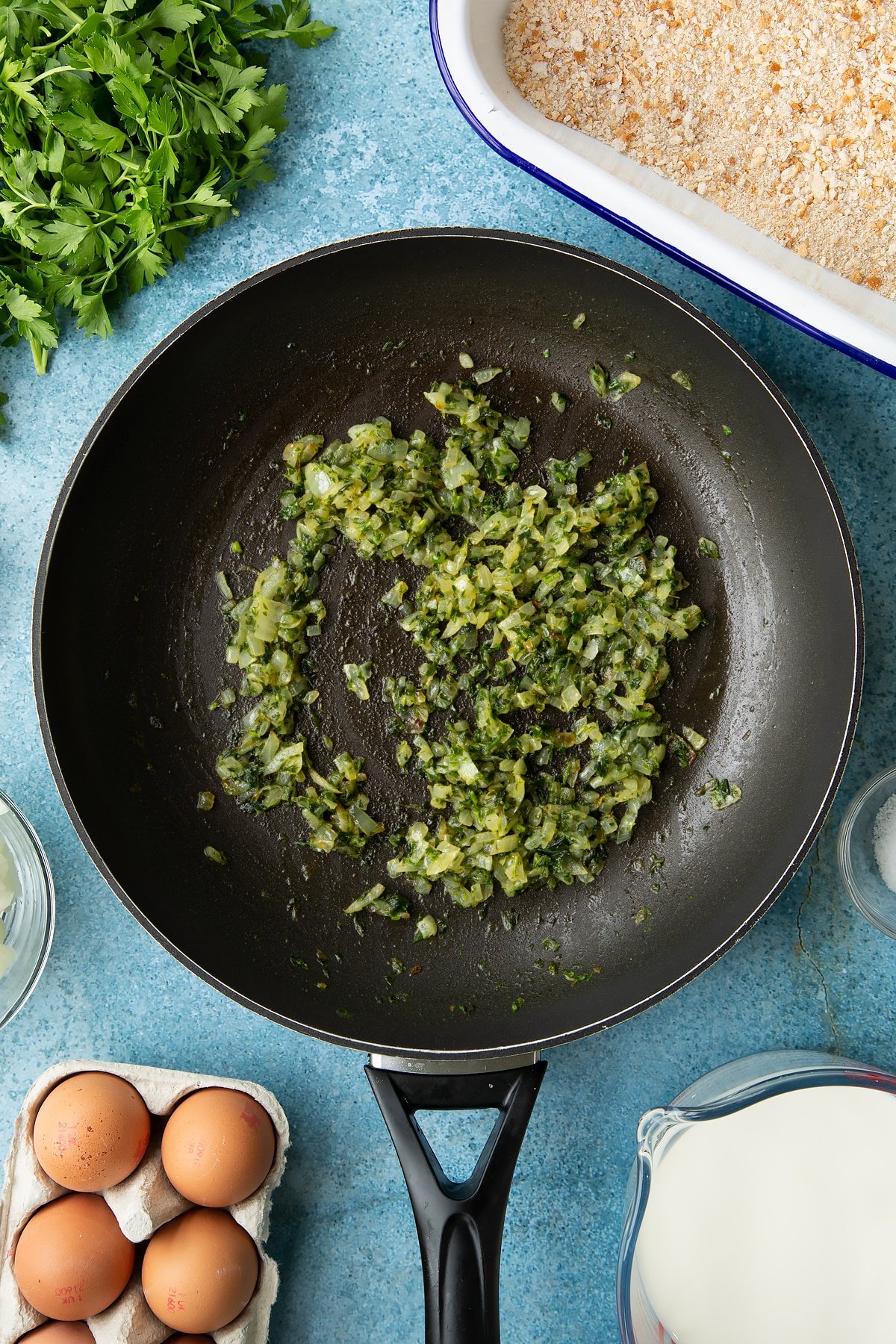
Put the milk and the remaining butter in a jug.
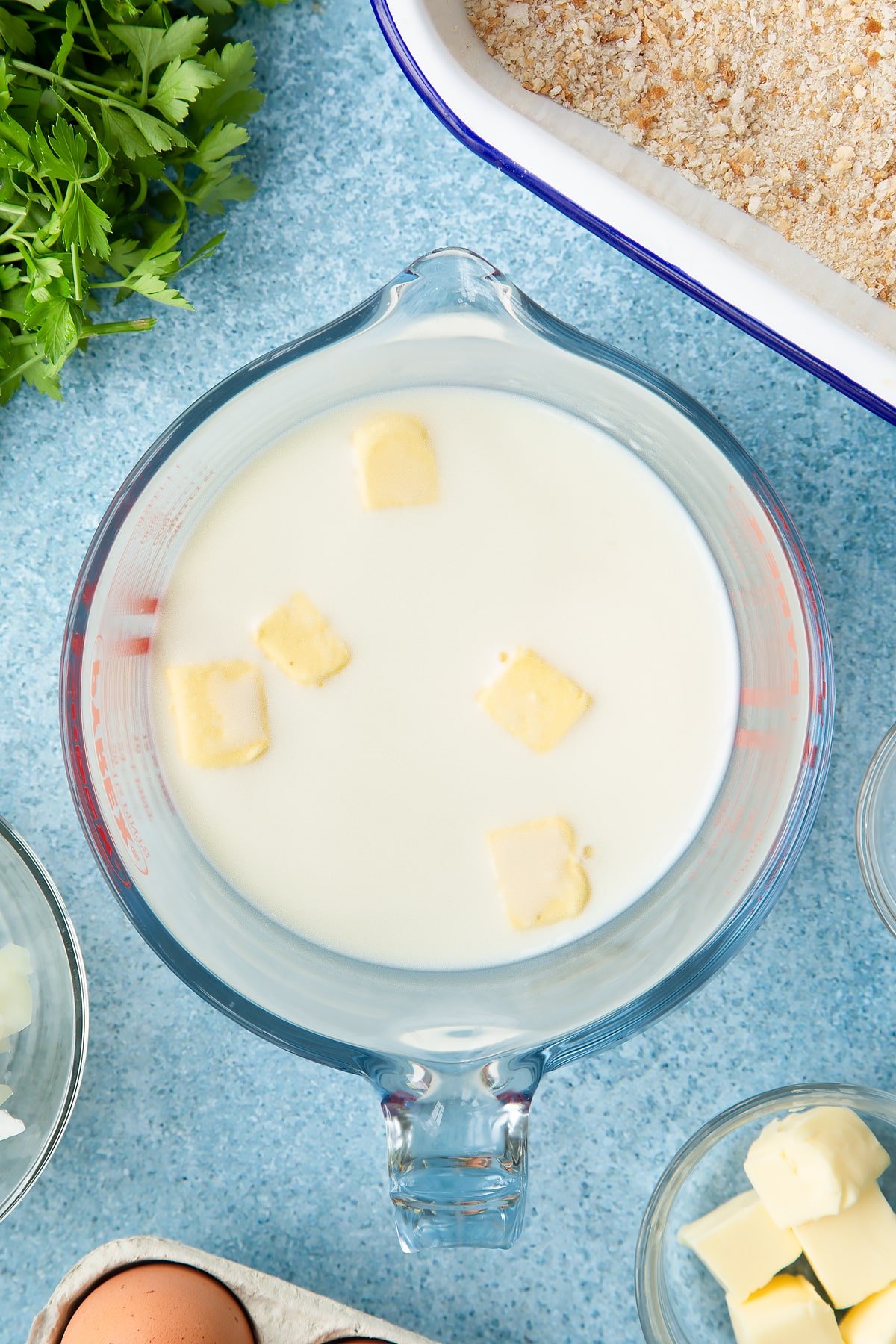
Microwave for about 90 seconds until hot but not boiling.
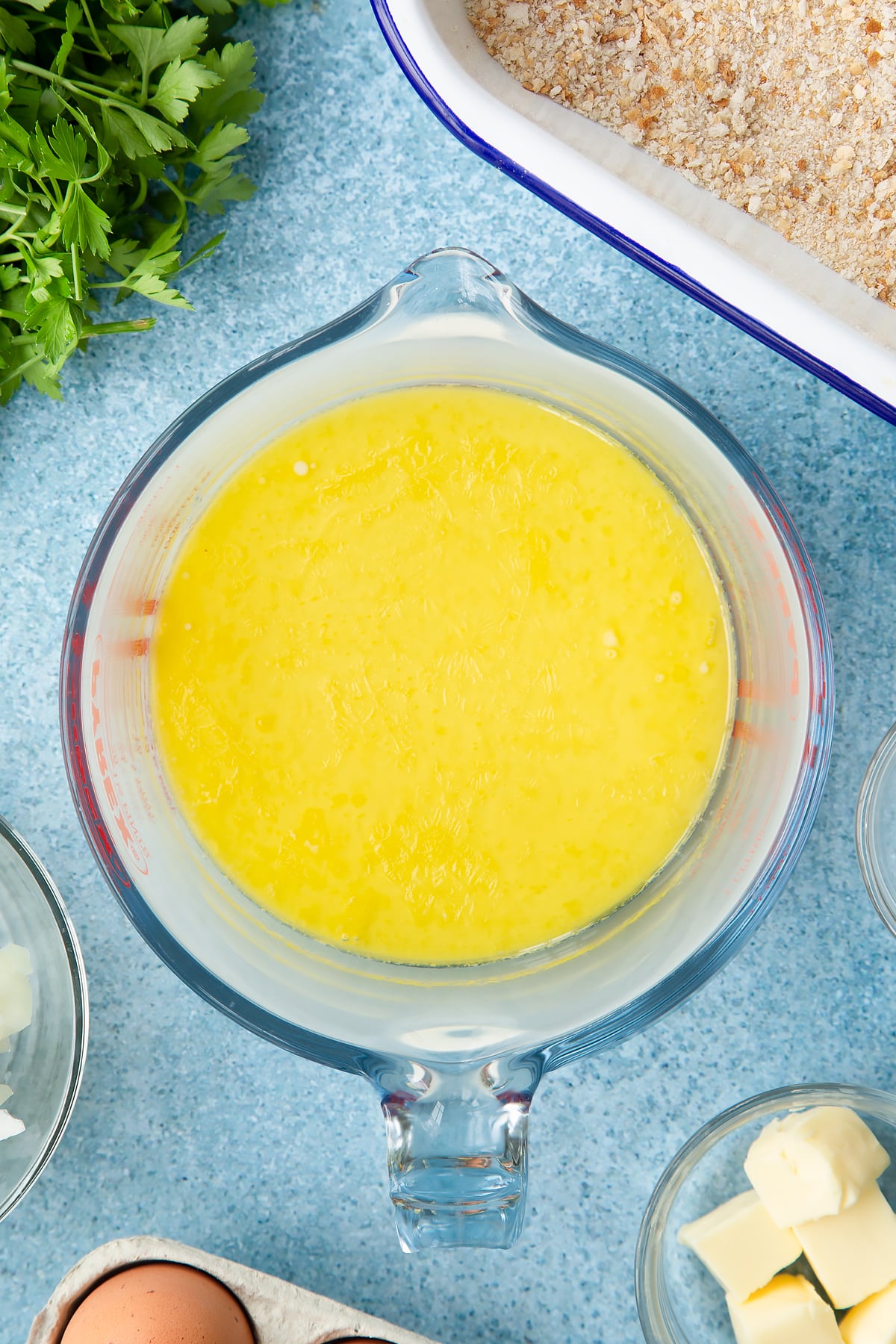
Spoon the onions over the breadcrumbs.
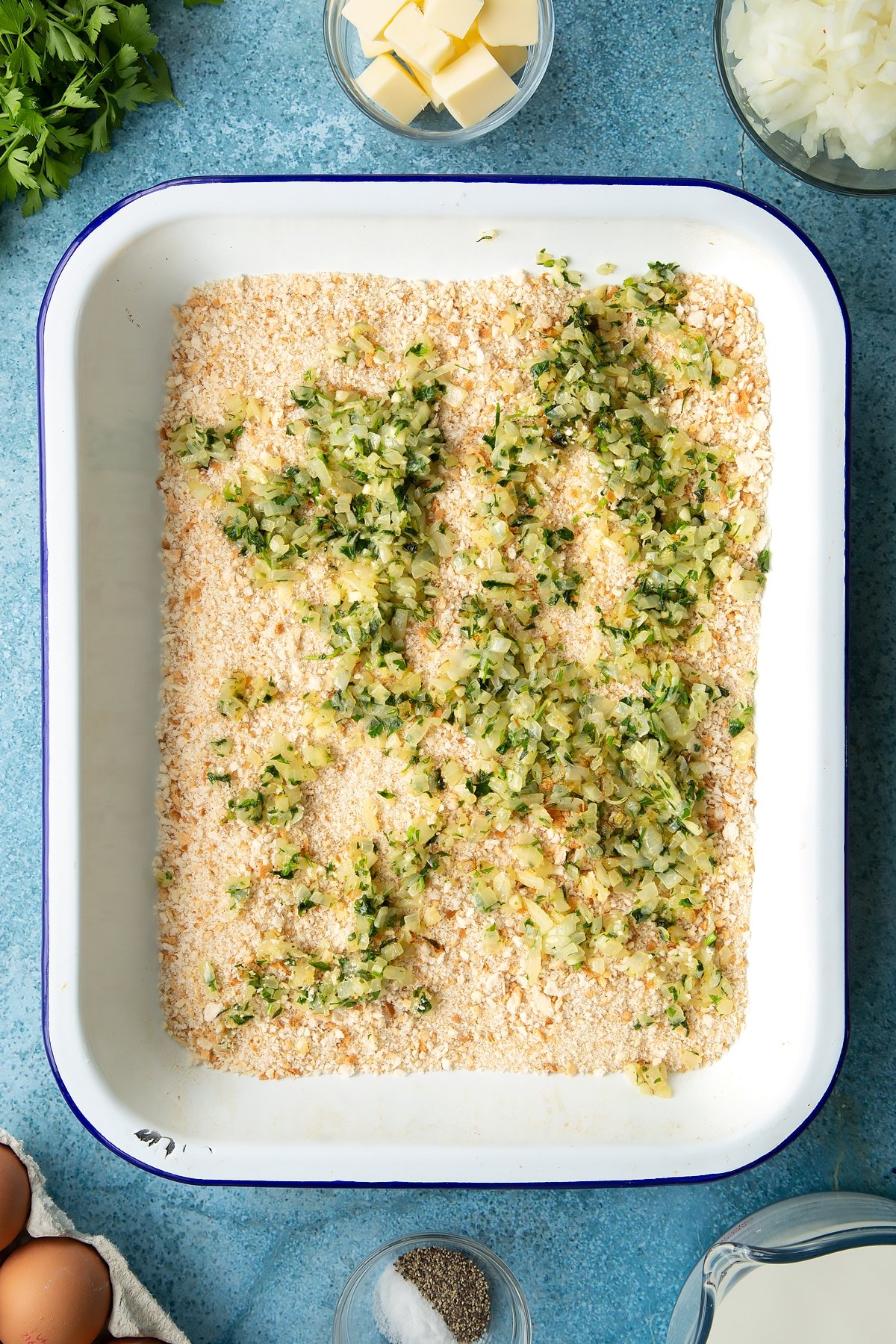
Pour in the hot milk.
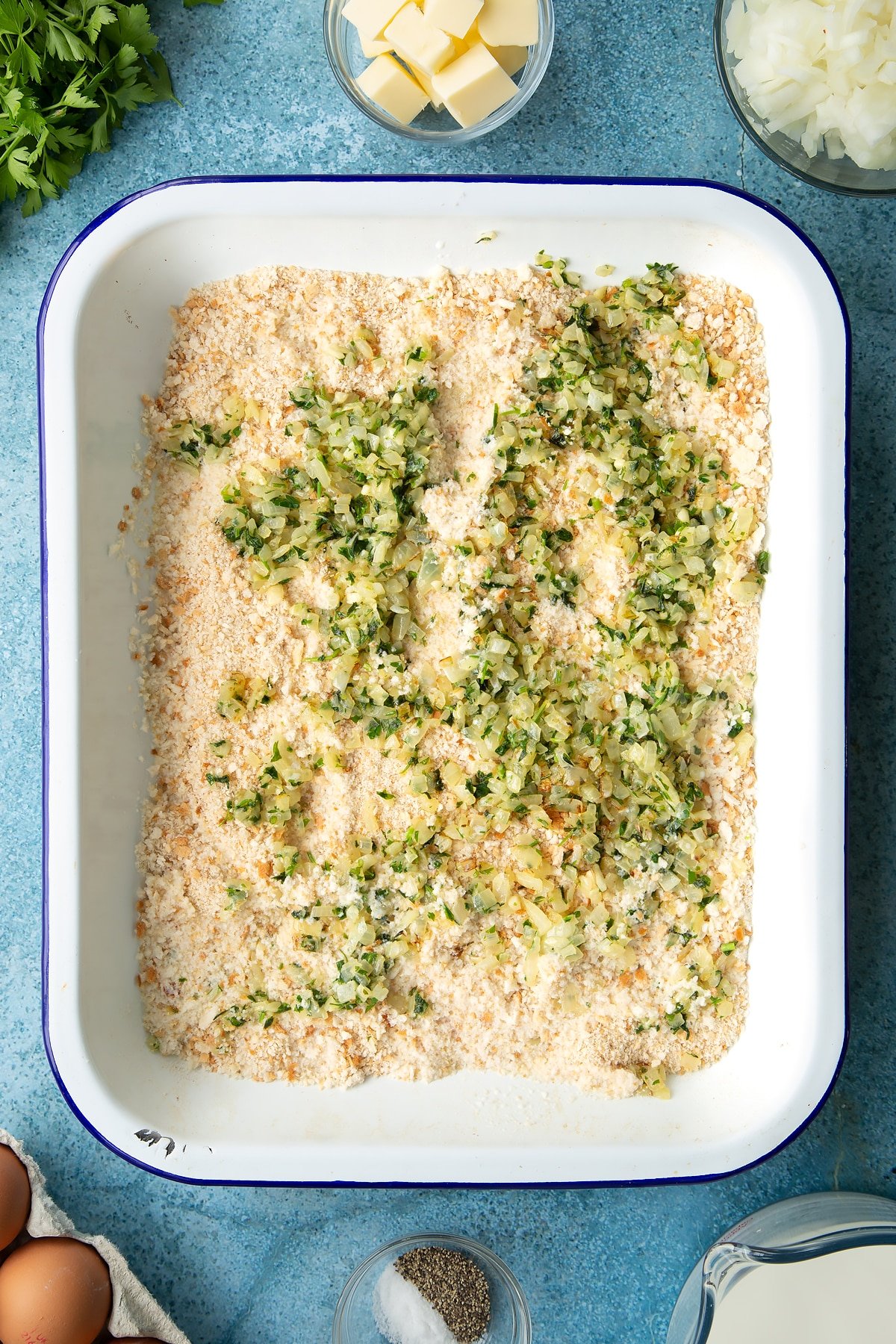
Now pour in the beaten egg, salt and pepper.
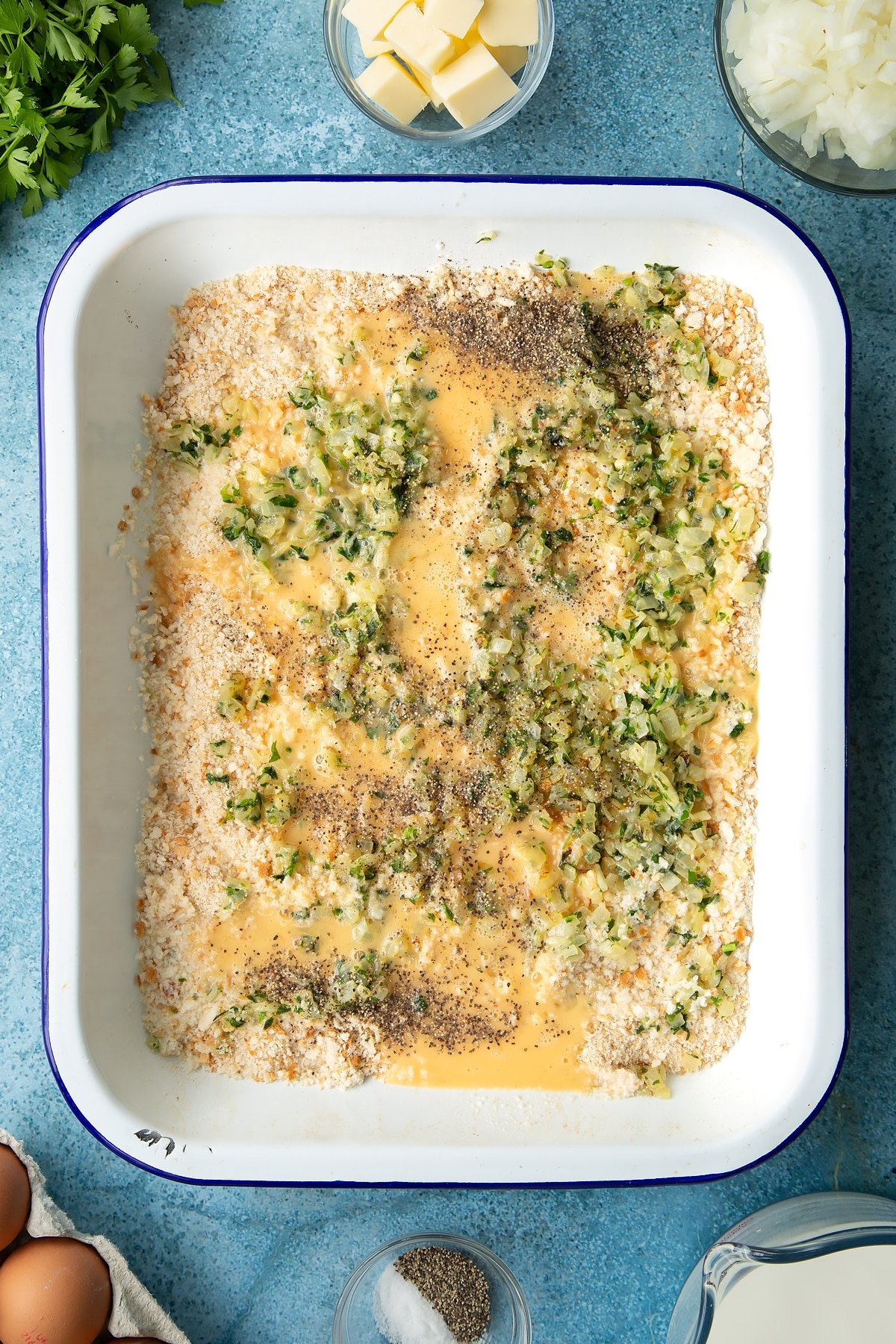
Stir everything together to give a stodgy looking dough.
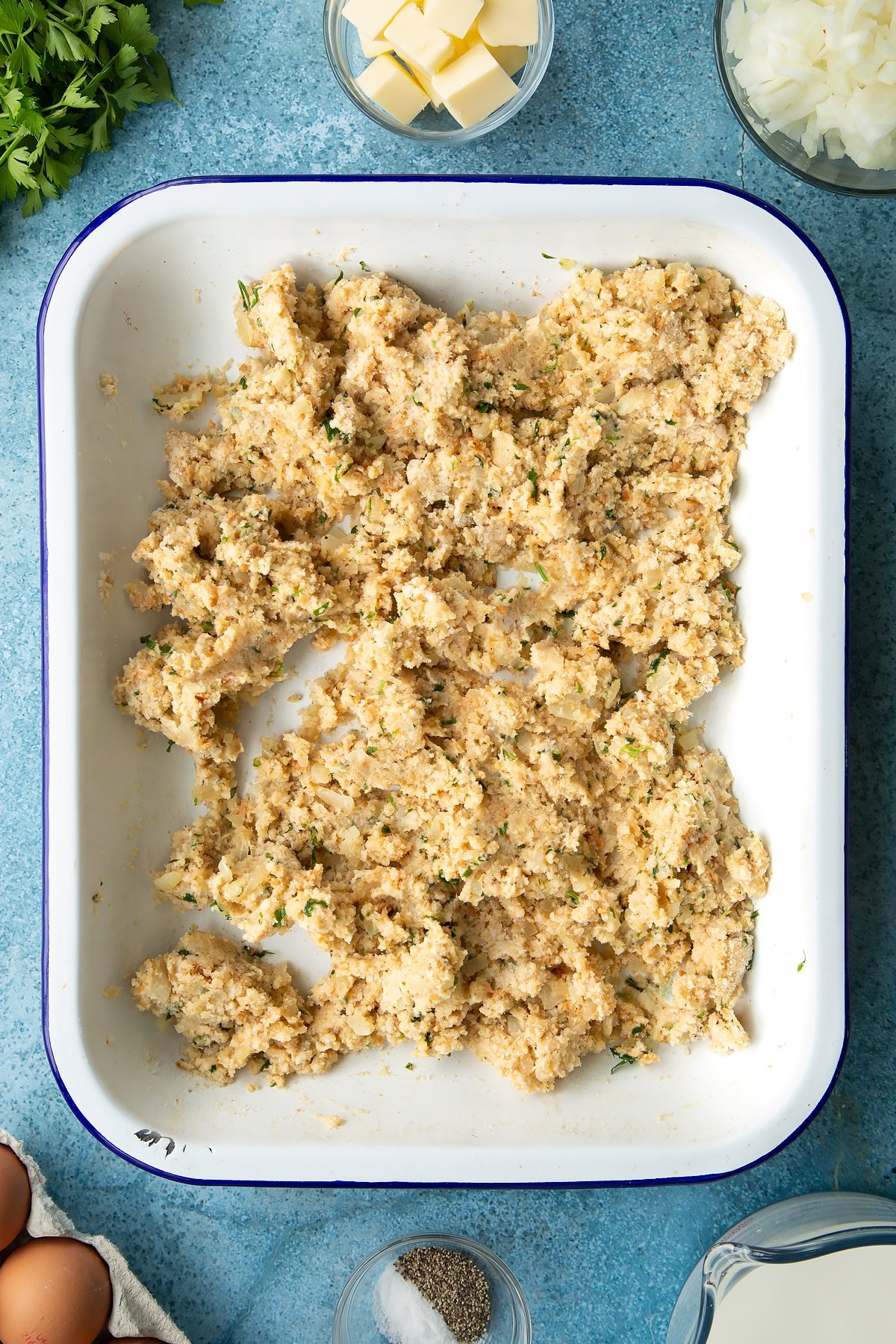
Fill a large, wide pot with water, add a little salt and bring to the boil, then turn to down so it's just barely simmering (only the odd bubble coming to the surface).
While the water is heating, divide your dough into 8 pieces of about 100g (3.5 oz) each. Wet your hands and begin to form your balls making sure they’re nice and dense.
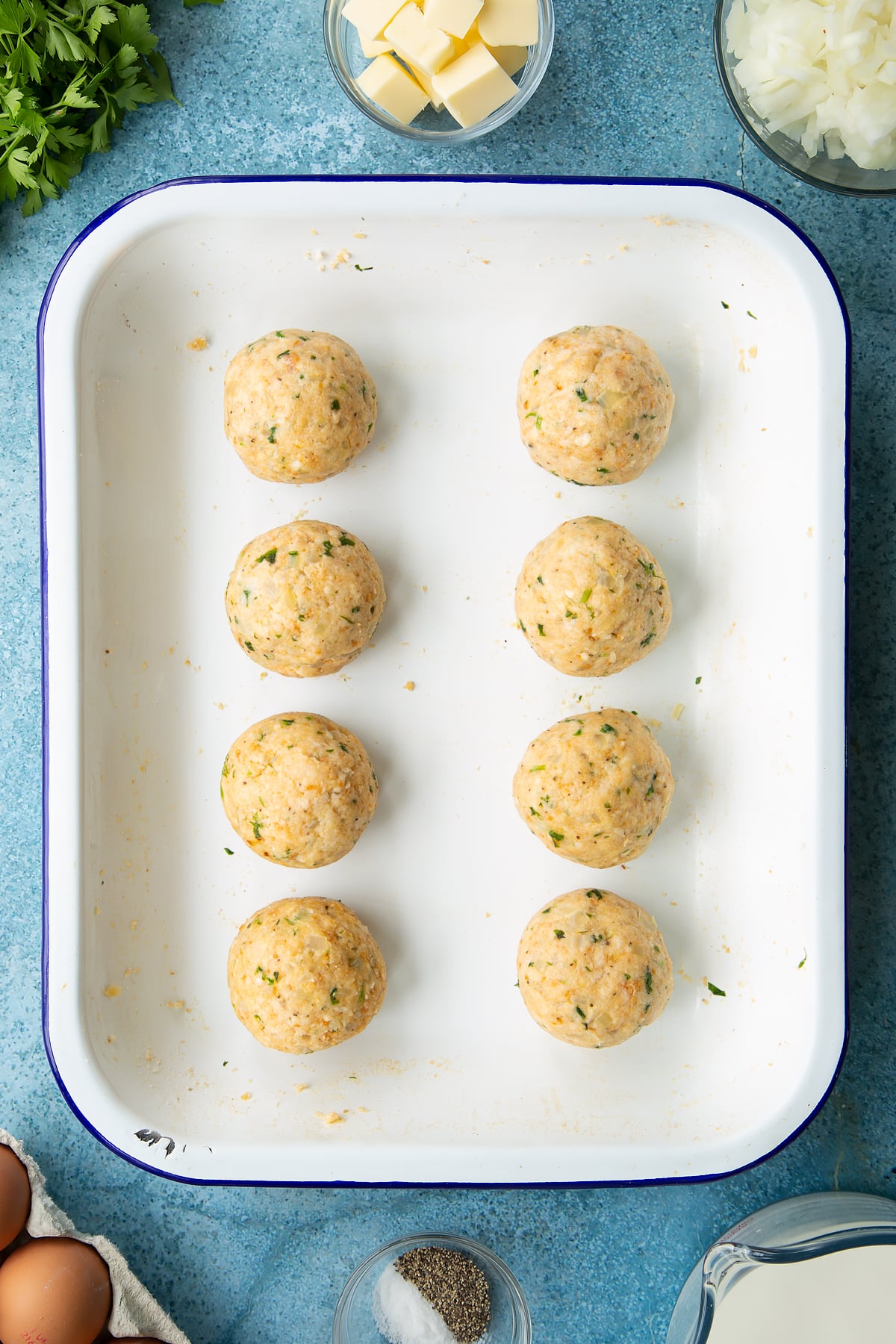
Carefully lower the dumplings into the water using your hands or slotted spoon.
Let them cook for 15-20 minutes. If the water doesn't cover them, you can gently turn half way with a slotted spoon. Make sure the water never boils.
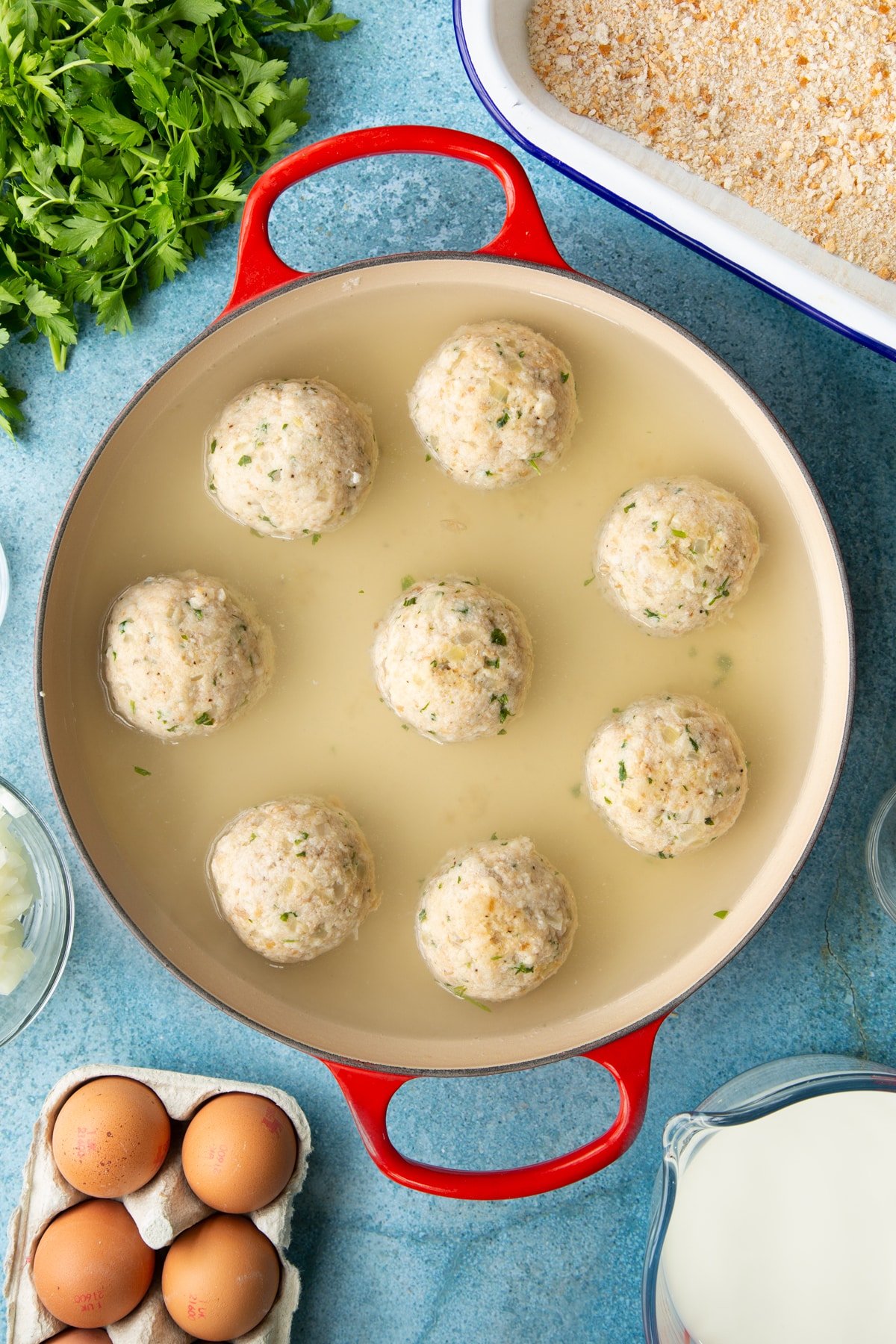
Lift the dumplings out of the water with a slotted spoon and serve.
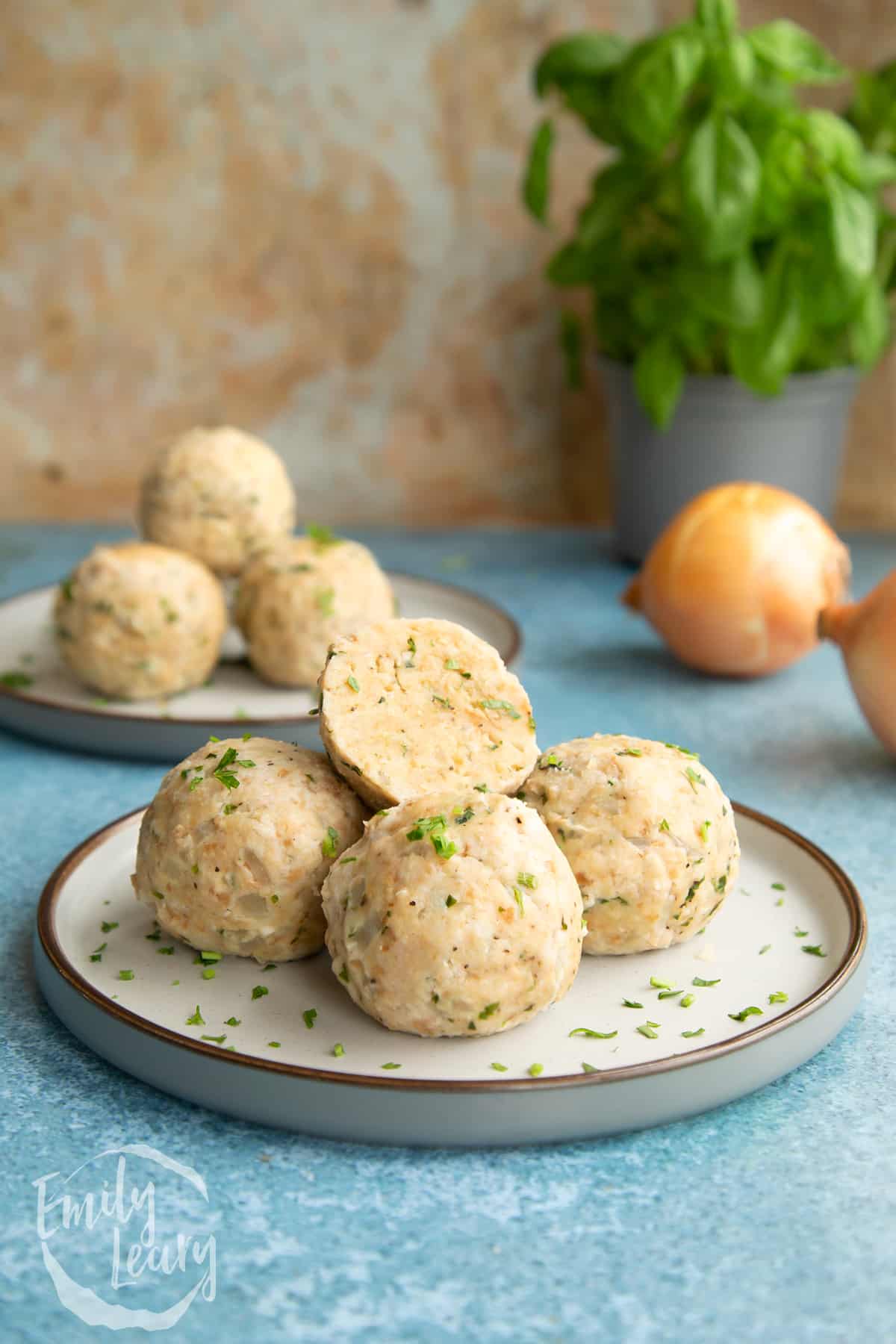
Tips, tricks and troubleshooting for the perfect German bread dumplings (Semmelknödel)
Is it easy to make Semmelknödel/German bread dumplings?
Making German bread dumplings is actually quite easy! The most time-consuming part is letting the bread dry out, but other than that, they come together quickly.
First, you process the stale bread into crumbs. The next step is to sweat the onions. This just means cooking them over low heat until they start to become translucent. Then, add the parsley and cook for 10 more minutes.
While the onions are cooking, put the milk and butter in a jug and microwave for about 90 seconds until hot but not boiling.
Once the onions are done, season and stir everything together to form a stodgy dough. Then, wet your hands and divide the dough into 8 pieces. Form each piece into a tight ball.
Finally, you'll carefully lower the dumplings into the water using a slotted spoon. Let them cook for 15-20 minutes. Then you're ready to serve them with some gravy, meat, vegetables or whatever you fancy!
While the recipe sounds complex, I've broken it down into simple, easy-to-follow steps. I've also included photos with each step, so you can check your dumplings are looking right as you go along.
Enjoy!
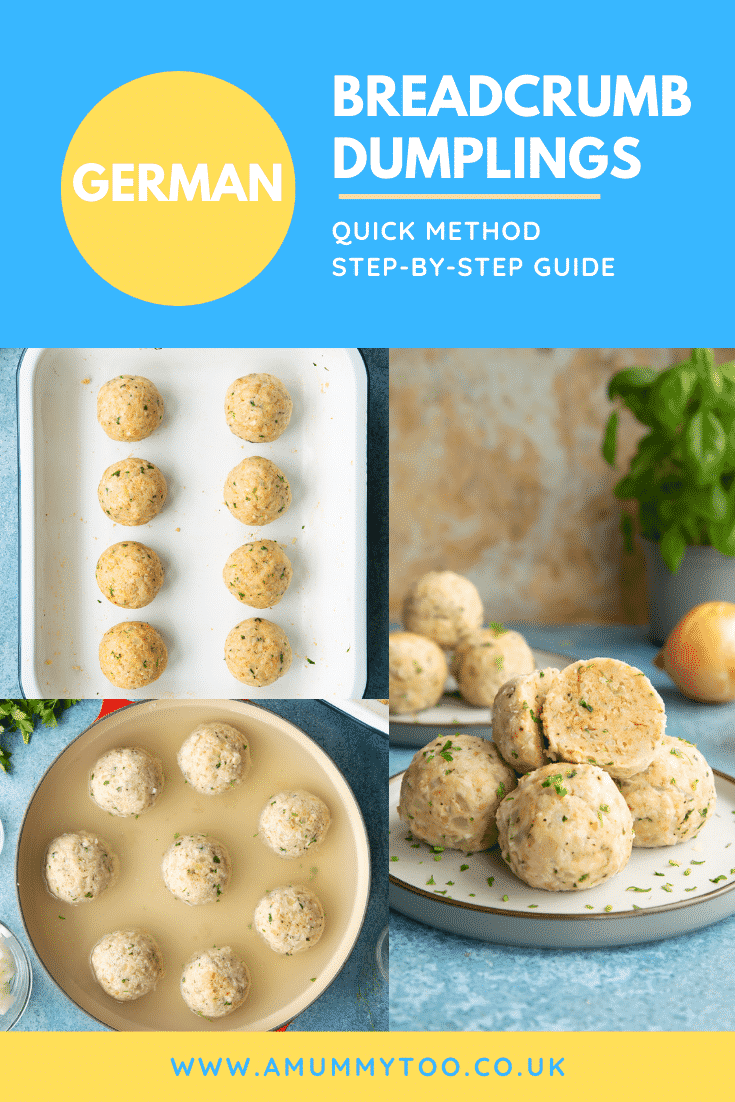
Will I need any special equipment to make German bread dumplings?
To make these Semmelknödel you'll need some standard kitchen equipment to make this recipe, (weighing scales, measuring spoons and a measuring jug.)
You'll also need a food processor to turn the bread into crumbs, but if you don't have one you can grate the bread or chop it into small cubes. You'll also need a large, wide saucepan to cook the dumplings in.
There's always a complete list of suggested equipment on the recipe card below my recipes if you're in doubt.
I also always include links to example products, so you can see exactly what I used to make each recipe.
What are Semmelknödel?
German bread dumplings, or Semmelknödel, are a classic German dish traditionally made with stale bread, milk, eggs, onions, and parsley. People typically serve them as a side dish, but you can also eat them on their own.
These dumplings are perfect for sopping up gravy or sauce, and their distinctive texture and flavour make them a delicious addition to any meal!
Do I have to use parsley in my German bread dumplings?
No, you don't have to use parsley in your dumplings. If you don't like parsley, or if you don't have any on hand, you can simply leave it out.
How can I tell if eggs have gone off?
The best way to tell if eggs have gone bad is to smell them. If they smell unpleasant, or like sulfur or fish, then they have gone bad and you should not use them.
British Lion has some eggcellent egg safety advice here.
How Can I Check If An Egg Is Fresh?
If you want to check whether an egg is fresh, you can do a simple float test. Fill a bowl with cold water and gently lower in your egg. If it sinks to the bottom and lies on one side, it's fresh. And if it floats to the top, it's past its best and you should discard it.
A spoiled egg floats because the air cell inside the egg has increased in size as the egg ages. This is because gas is produced as the contents degrade.
However, a float test is not foolproof, as some spoiled eggs can sink. You should always make sure an egg is fresh before adding it to a recipe. So make sure you crack your egg into a separate bowl or cup first to check it.
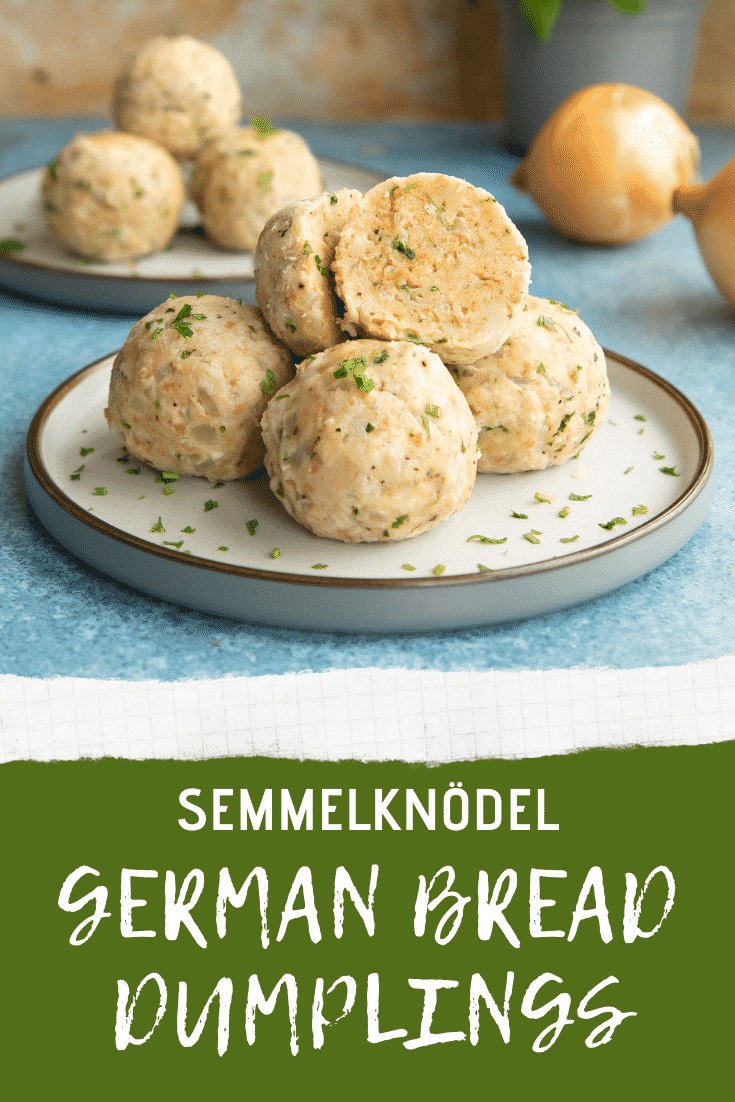
Can I make German bread dumplings without eggs?
Yes, you can make your dumplings without eggs. Simply omit the eggs from the recipe. The dumplings will be slightly less rich and fluffy, but will still be delicious!
How can I tell if my butter has gone off?
The best way to tell if your butter has gone bad is to smell it. If it smells sour, rancid, or just not like butter, then it has gone bad and you should not use it.
Can I make German bread dumplings without butter?
Yes, you can make German bread dumplings without butter. Simply omit the butter from the recipe. The dumplings will be slightly less rich, but will still be delicious!
How can I tell if milk has spoiled?
When milk spoils, enzymes produce compounds that give it a sour smell. So the best way to tell if milk has spoiled is to smell it.
If your milk smells sour, rank, or just not like milk, then it has gone bad and you should not use it.
Can I make German bread dumplings without milk?
Yes, you can make your Semmelknödel dumplings without milk.
You can omit the milk from the recipe and use plant milk instead. Or if you don't want any milky flavour, you could use the same quantity of vegetable or chicken stock.
However, this will most likely change the texture of the bread dumplings a little.
Are these German bread dumplings suitable for vegetarians?
Yes, these Semmelknödel are suitable for vegetarians. They contain no meat, fish or animal-derived products like gelatine. However, they contain dairy and egg so they aren't suitable for vegans.
Always make sure that you double-check all of your ingredients labels to ensure that they are vegetarian.
Also, don't forget to check anything extra that you intend to serve with your recipe. For example, if you're serving German bread dumplings with gravy, make sure that the gravy is also vegetarian.
Are these German bread dumplings suitable for vegans?
No, German bread dumplings are not suitable for vegans as they contain dairy and egg.
To make them suitable for vegans, simply omit the eggs and use plant milk instead of dairy milk. Unsweetened soy milk or unsweetened almond milk would work brilliantly.
You can use a vegan egg replacer to work as a binding element in the dumpling mix. Ground chia or flax seeds would probably work well - though I haven't tried a vegan version of this recipe so I can't be sure.
To make a chia or flax egg (equivalent to 1 egg) you'll need to:
- Combine 1 tablespoon (15ml) of chia or crushed flax seeds with 3 tablespoons (45ml) of water.
- Mix well and allow to sit for 5 minutes, or until the mixture has thickened and resembles a beaten egg.
- Flax seeds must be crushed before mixing with water as they have thick impenetrable shells. Chia seeds won't need to be crushed.
The above method makes the equivalent to 1 egg, so you would need to make 3 chia/flax eggs for this recipe.
If you give it a go let me know how your vegan Semmelknödel dumplings turned out in the comments below!
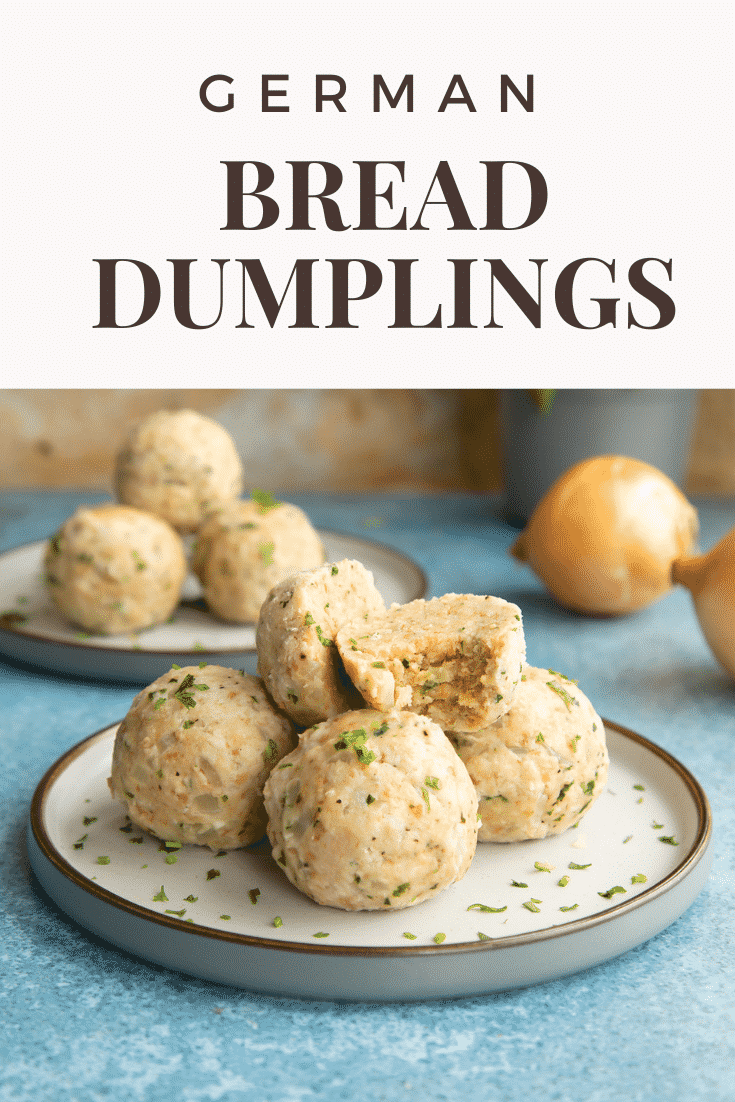
Can I make German bread dumplings gluten-free?
Yes, you can make German bread dumplings gluten-free.
To make German bread dumplings gluten-free, simply use some gluten-free bread instead of wheat bread.
You can find gluten-free bread in the bread aisle of most supermarkets. Though sometimes you'll find it on a dedicated 'Free From' aisle.
You could also make your own gluten-free bread using a bread mix. This gluten-free bread mix from Amazon looks easy to use!
Are these German bread dumplings keto-friendly?
No, German bread dumplings are not keto-friendly as they contain bread which is high in carbs.
For a keto dumpling recipe, you could take inspiration from a German dish called 'Kohlrouladen', and make a filled steamed dumpling using a savoy cabbage leaf for the filling.
Are these German bread dumplings healthy?
German bread dumplings are not particularly healthy or unhealthy. They contain a fair amount of carbs and some fat, but they also have protein and other nutrients.
To make German bread dumplings healthier, you could try making them with whole wheat bread instead of white bread.
You could also use less butter in the recipe, or even omit it altogether. The dumplings will be slightly less flavourful without the butter, but they will still taste good.
Are these German bread dumplings safe to eat while pregnant?
Yes, German bread dumplings are safe to eat while pregnant. They contain no ingredients that are off-limits for pregnant people.
However, as with any dish, it's always best to err on the side of caution and check with your doctor or midwife before eating German bread dumplings (or any other dish) during pregnancy.
Make sure that all of your ingredients are in good condition and that you prepare this meal safely and hygienically.
A Mummy Too does not offer medical advice. Please seek help from a medical professional if you need further information or have any concerns.
Are German bread dumplings suitable for babies and toddlers?
Semmelknödel may not be suitable for babies and toddlers as they contain gluten. They could also pose a choking hazard for young children.
To make Semmelknödel suitable for babies and toddlers, you could try making them with gluten-free bread.
You could also cut them into appropriate size and shape for your baby or child. Cut small, round foods, like grapes and cherry tomatoes, into small pieces.
Always keep babies supported upright while eating and supervise your baby when they’re eating in case they start to choke.
A Mummy Too does not give medical advice. If you have any questions or concerns please speak to a health professional.
What goes well with Semmelknödel?
German bread dumplings go well with a variety of dishes or the leftovers make a great snack.
Semmelknödel traditionally goes with gravy, roasted meats or stews. Although you can serve your German bread dumplings as a side dish, or on their own as a main course.
Semmelknödel is also great cold, with a little salad or some pickles on the side.
Does it matter if I use baking margarine or butter in the dumplings?
You can make German bread dumplings with either margarine or butter, as the butter isn't really there to aid the texture.
In my opinion, butter gives the dumplings (and everything) a richer flavour. However, feel free to use whichever you prefer, or have to hand.
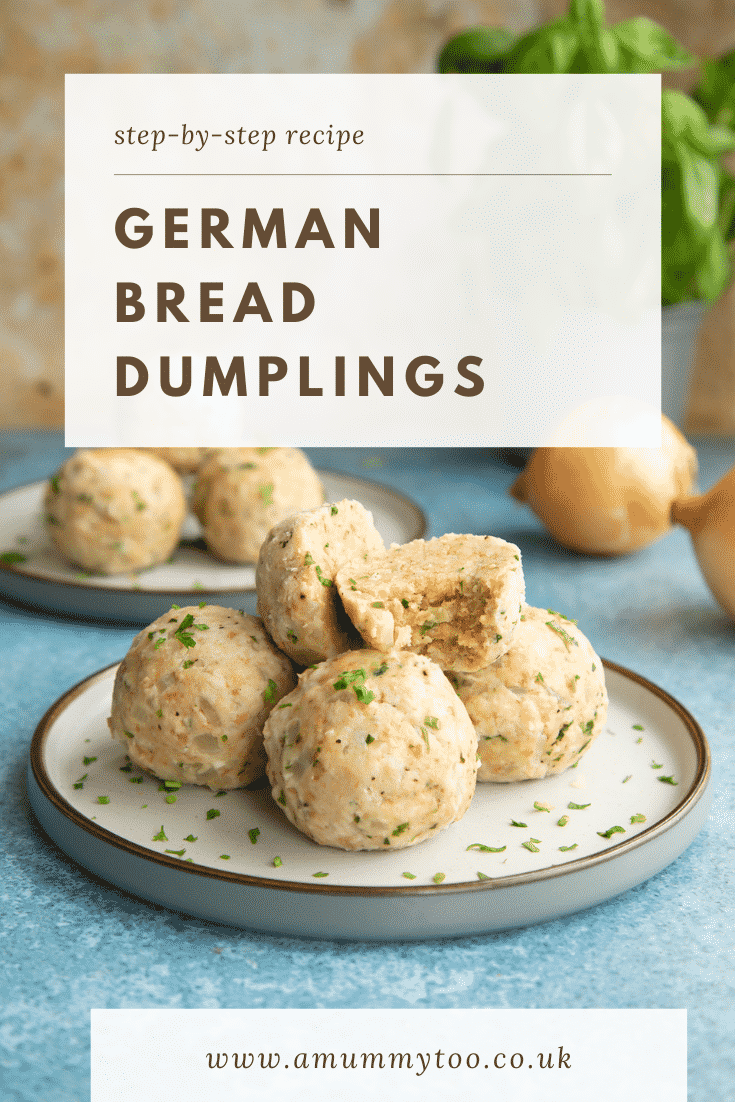
How should I store German bread dumplings?
You should store your German bread dumplings in an airtight container in the fridge. You can also freeze the dumplings for up to 3 months.
How long will German bread dumplings keep?
German bread dumplings will keep in the fridge for up to 2 days, or in the freezer for up to 3 months.
Can I leave German bread dumplings out on the counter?
You shouldn't leave German bread dumplings out on the counter. To keep them from spoiling, you need to keep your Semmelknödel in the fridge or freezer.
German bread dumplings that have been left out on the counter for more than 2 hours should be thrown away.
Can I make German bread dumplings ahead?
Yes, you can make your German bread dumplings ahead and store them in the fridge or freezer.
To make German bread dumplings ahead, simply prepare them as per the recipe instructions. Then store them in an airtight container in the fridge for up to 2 days, or in the freezer for up to 3 months.
When you're ready to eat the dumplings, simply reheat them in boiling water for 10 minutes (if they're from the fridge) or 15 minutes (if they're from the freezer).
Can I keep German bread dumplings in the refrigerator?
Yes, you can keep your German bread dumplings in the refrigerator for up to 2 days. Store them in an airtight container to keep them fresh and to protect them from contaminants.
Can I freeze German bread dumplings?
Yes, you can freeze German bread dumplings. Simply place them in an airtight container and store them in the freezer for up to 3 months.
You can defrost them overnight in the fridge, or cook them from frozen. They will probably hold their shape better if you cook them from frozen in the oven as directed in the question below.
Or you can reheat them in boiling water for 10 minutes (if they're from the fridge) or 15 minutes (if they're from the freezer).
How can I reheat my German bread dumplings?
German bread dumplings are best served fresh, but they can be reheated if necessary.
To reheat German bread dumplings, place them in a baking dish with a little water and cover with foil. Bake in a preheated oven at 180°C (350°F, gas mark 4) for 10-15 minutes, until heated through.
Or, you can place your German bread dumplings in a pan of boiling water for 5-10 minutes until heated through. You could also heat them in the microwave
What is the best way to defrost German bread dumplings?
German bread dumplings can be defrosted overnight in the fridge, or cooked from frozen.
To defrost German bread dumplings overnight, simply place them in an airtight container in the fridge and leave them to defrost overnight.
Or, you can cook German bread dumplings from frozen. Simply place them in a baking dish with a little water and cover with foil. Bake in a preheated oven at 180°C (350°F, gas mark 4) for 10-15 minutes, until heated through.
You could also defrost them in the microwave - checking them in 20-second increments.
Can I make these German bread dumplings in a different quantity?
Yes, German bread dumplings can easily be made in different quantities. Simply adjust the ingredients to suit the number of dumplings you want to make.
For example, this recipe makes 8 dumplings. So you could divide the ingredients by 8 to get the ingredient quantities for 1 dumpling, then multiply the ingredients by 16 to make 16 dumplings.
Can I make German bread dumplings in a stand mixer such as a KitchenAid or Kenwood Mixer?
There's no need to use a stand mixer for this recipe, as German bread dumplings are very easy to make by hand.
Can I make German bread dumplings with a food processor?
Yes, you'll need to use a stand mixer to break up your stale bread into crumbs. However, you should mix the rest of the ingredients by hand so you don't turn the dumplings into a dense puree.
Can I use frozen chopped onion?
Yes, you can use frozen chopped onion in German bread dumplings. Simply omit the fresh onion from the recipe and add an equivalent amount of frozen chopped onion. There's no need to thaw the onion before adding it to the recipe.
Do I have to use stale bread?
Yes, German bread dumplings are traditionally made with stale bread. This is because stale bread absorbs more liquid than fresh bread, so it's less likely to make the dumplings soggy.
If you don't have any stale bread, you can dry out fresh bread by placing it on a baking tray in a low oven (about 50-60°C, or 120-140°F) for 10 minutes.
Can I use a different kind of bread?
Yes, German bread dumplings can be made with any type of bread, as long as it's stale, or relatively dry. This recipe uses white bread, but you could also use wholemeal bread, rye bread or even sourdough.
How can I make sure my Semmelknödel turn out perfectly?
German bread dumplings are very easy to make, but there are a few things you can do to ensure they turn out perfectly.
- First of all, make sure your bread is stale. If it's too fresh, the dumplings will be dense and heavy. You can either leave your bread out overnight to stale, or you can dry it out in a low oven (about 50-60°C, or 120-140°F) for 10 minutes.
- Secondly, don't overmix the ingredients. Semmelknödel should be light and fluffy, so mix the ingredients just until they're combined. Overmixing will make the dumplings tough.
- Finally, make sure you cook the dumplings long enough. German bread dumplings should be cooked all the way through, otherwise, the texture won't be right.
- Keep some extra breadcrumbs and extra milk on hand. If your mixture is too dry to form into balls, add a touch of milk. If it is too wet, mix in some extra breadcrumbs.
My German bread dumplings are too dense/heavy. What went wrong?
There are a few things that could cause your German bread dumplings to be too dense or heavy.
- If you used very stale, rock hard bread, this can make the dumplings heavier. Try using only slightly stale bread next time.
- If you didn't squeeze all of the moisture out of the bread before adding the other ingredients, this can also make the dumplings too dense. Make sure that you squeeze out as much moisture as possible from the bread before proceeding with the recipe.
- Another common cause of heavy Semmelknödel is not using enough eggs. The egg whites help to lighten and bind the dumplings, so if you don't use enough of them, the dumplings will be dense.
- Finally, over-working the dough can also make German bread dumplings dense. Be careful not to over-mix the dough or the bread will become more like mash.
Why did my German bread dumplings fall apart or turn out crumbly?
There are a few things that could cause German bread dumplings to fall apart or turn out crumbly.
- If you didn't squeeze all of the moisture out of the bread before adding the other ingredients, this can make the dumplings too wet and crumbly. Make sure that you squeeze out as much moisture as possible
- from the bread before proceeding with the recipe.
- Another common cause of crumbly German bread dumplings is using too much flour. If you add too much flour to the dough, it will be dry and crumbly. Be careful not to add too much flour when mixing the ingredients together.
- Finally, over-working the dough can also make German bread dumplings crumbly. Be careful not to over-mix the dough or the bread will become more like mash.
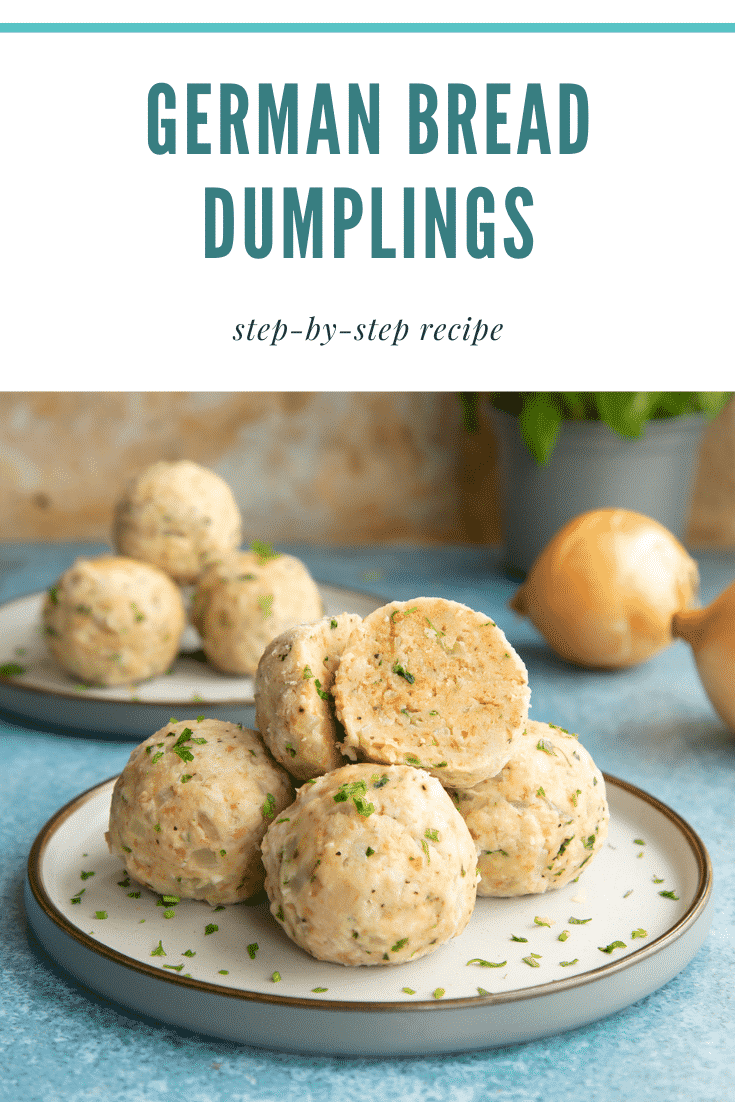
How can I add/change the flavours in these German bread dumplings?
German bread dumplings are very versatile and can be flavoured in many different ways.
One common way to flavour German bread dumplings is to add some chopped herbs, such as parsley, chives or thyme. You could also add grated cheese, diced ham or bacon, or even dried fruit.
Nutmeg, marjoram or even pre-cooked bacon pieces can all add lovely extra flavour if you want to add a more savoury flavour.
What are some other German recipes I might enjoy?
If you're looking for more German recipes to try, why not try making some Sauerkraut, Spätzle or Bavarian pretzels?
Where is the origin of Semmelknödel?
Semmelknödel is a German dish that consists of bread dumplings. The dish is thought to have originated in either Munich or Bavaria, but it is now eaten all over Germany. Semmelknödel are usually made with stale bread, milk, eggs, butter, salt and pepper. They are often served with gravy or sauce, and
Who invented Semmelknödel?
There is some debate over the origins of Semmelknödel, but it is thought that they were invented in South or East Germany in the early 19th century.
Semmelknödel is popular in southern Germany, Austria and the Czech Republic, as well as northern Italy. German immigrants also brought the dish to the United States, where it is now enjoyed by many people.
Print this German bread dumplings recipe
German Bread Dumplings (Semmelknödel Recipe)
Ingredients
- 300 g (10.6 oz) stale white bread crusty rolls are perfect for this
- 4 tbsp salted butter
- 1 medium onion finely diced
- 15 g (0.5 oz) fresh parsley finely chopped
- 2 cloves garlic finely chopped, optional
- 300 ml (10.1 floz) milk
- 3 medium free range eggs lightly beaten
- 1/2 tsp (0.5 tsp) freshly ground black pepper
- 1/2 tsp (0.5 tsp) salt
Equipment
- Large nonstick baking tray
- Large saucepan wide and shallow
Instructions
- Break the stale bread into smallish chunks and drop into a food processor to turn into large crumbs. If you don't have a food processor, you can grate the bread or chop it up into small cubes. Spread in a tray and leave to dry out further overnight.
- Place half the butter in a frying pan and sweat the onions over a medium heat until they start to become translucent, then add the parsley and cook for 10 minutes on low.
- Put the milk and remaining butter in a jug and microwave for about 90 seconds until hot but not boiling.
- Spoon the onions over the breadcrumbs.
- Pour in the hot milk.
- Now pour in the beaten egg, salt and pepper.
- Stir everything together to give a stodgy looking dough. See notes if you need to adjust the texture.
- Fill a large, wide pot with water, add a little salt and bring to the boil, then turn to down so it's just barely simmering (only the odd bubble coming to the surface).
- While the water is heating, divide your dough into 8 pieces of about 100g (3.5 oz) each. Wet your hands and begin to form your balls making sure they’re nice and dense.
- Carefully lower the dumplings into the water using your hands or slotted spoon.
- Let them cook for 15-20 minutes. If the water doesn't cover them, you can gently turn half way with a slotted spoon. Make sure the water never boils.
- Lift the dumplings out of the water with a slotted spoon and serve.
Video
Notes
Nutrition
Pin this German bread dumplings recipe
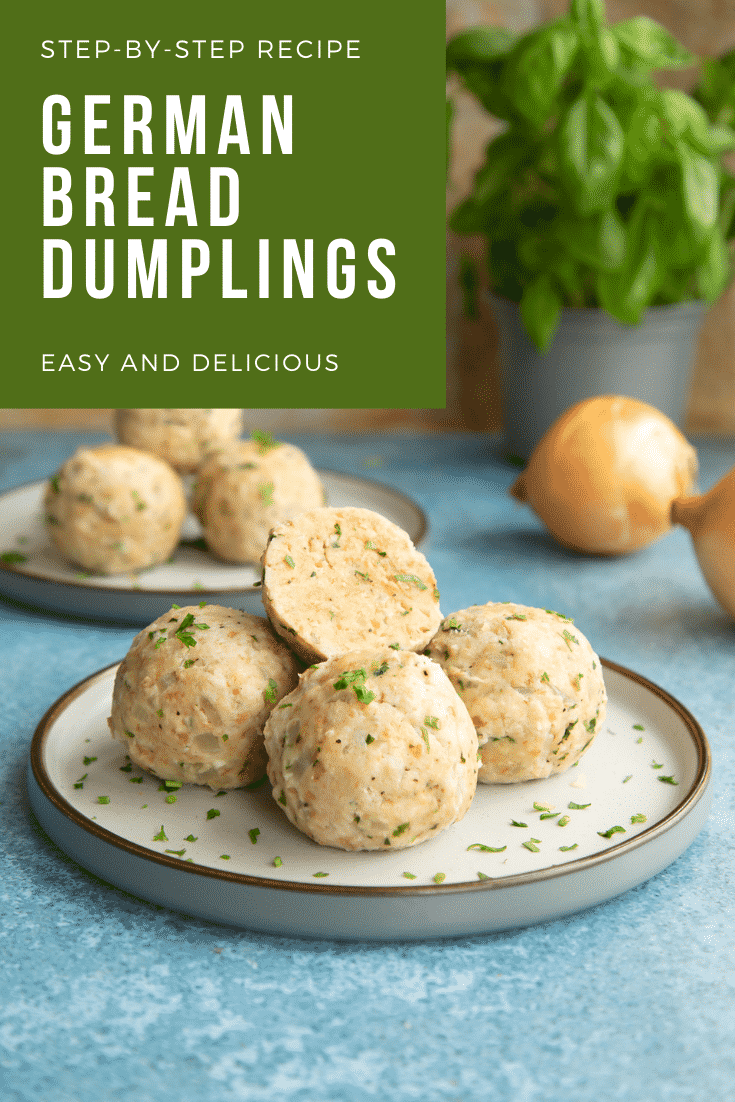
More cooked dinner recipes to try
Have you got my book?

'This is a great kids cookery book. Emily is a star' - Simon Rimmer
'The book I'd like to force into any mother's kitchen' - Prue Leith
"A fab book with a plan." - Jane Devonshire, 2016 Masterchef UK winner
'Emily has managed to combine her mummy knowledge and passion for food to make a truly helpful and brilliant cookbook' - Priya Tew, RD, BSc (Hons), Msc
Get Your Kids to Eat Anything is an achievable 'how to' for parents in the battle to overcome picky eating and 'make new the norm'. Emily Leary's unique 5-phase programme looks at the issue of 'fussy eating' in a holistic way that links imagination with food, and which situates parents alongside - not in opposition to - their children.

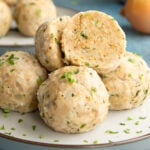
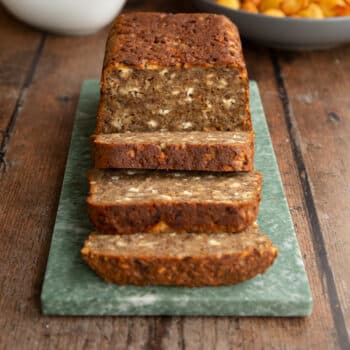
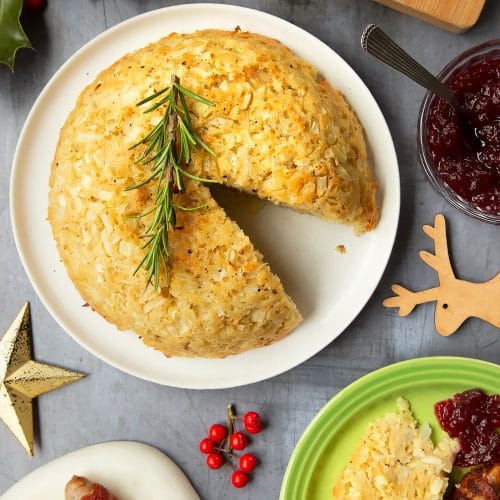
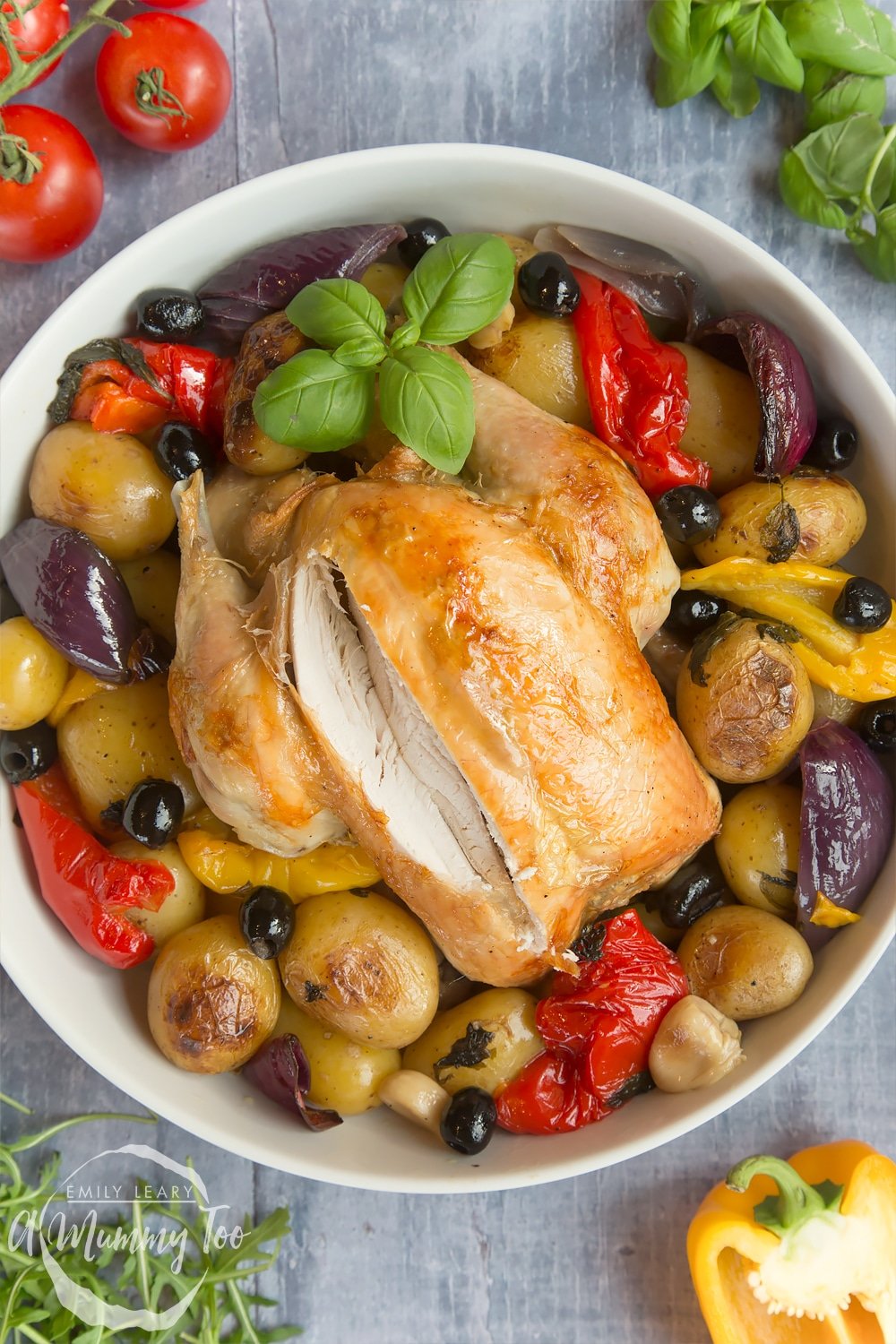
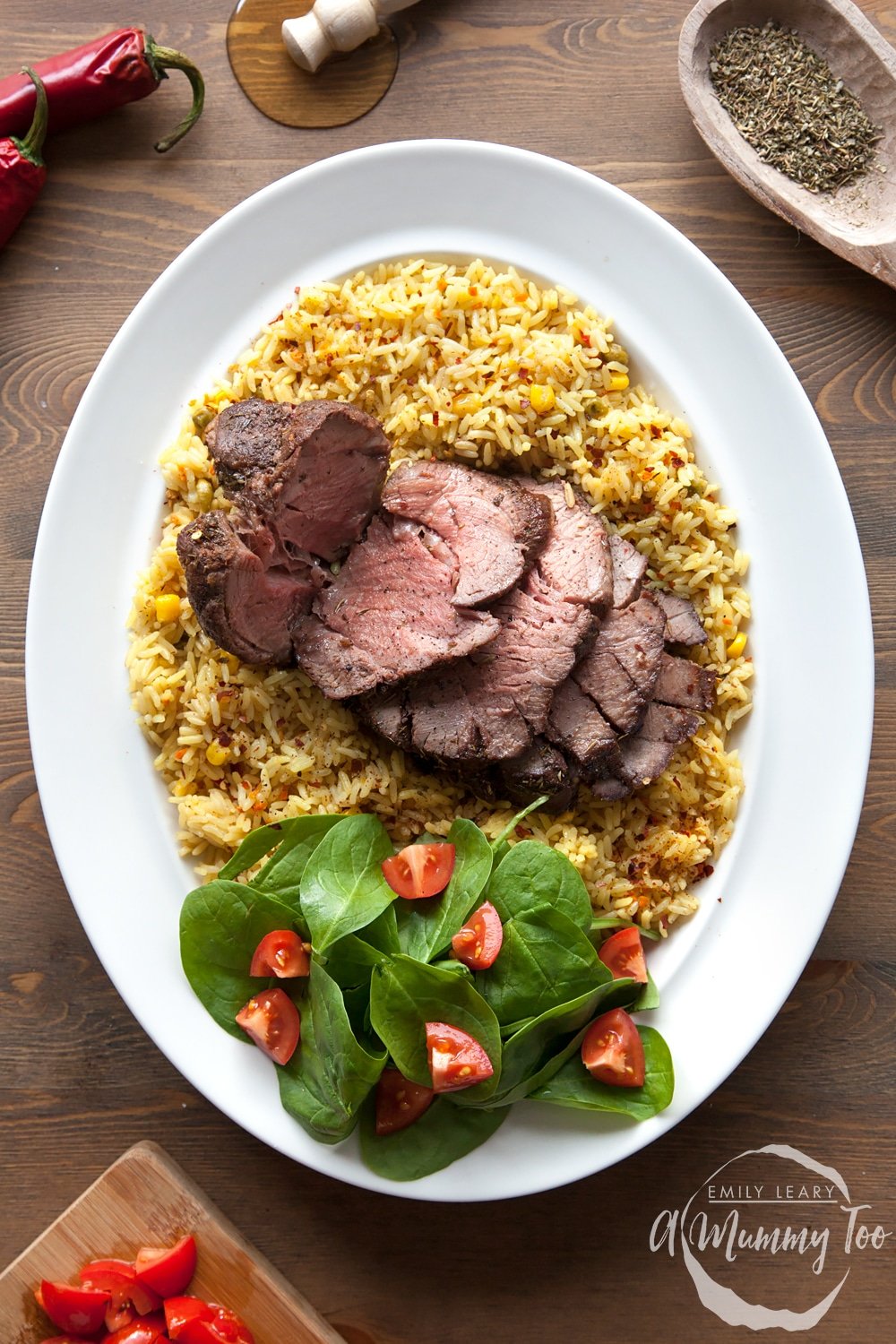
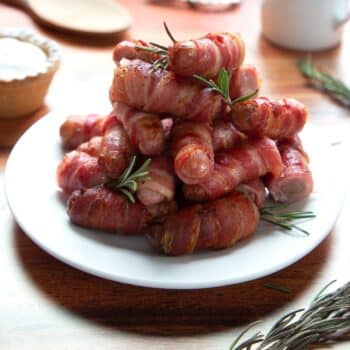
Leave a Reply